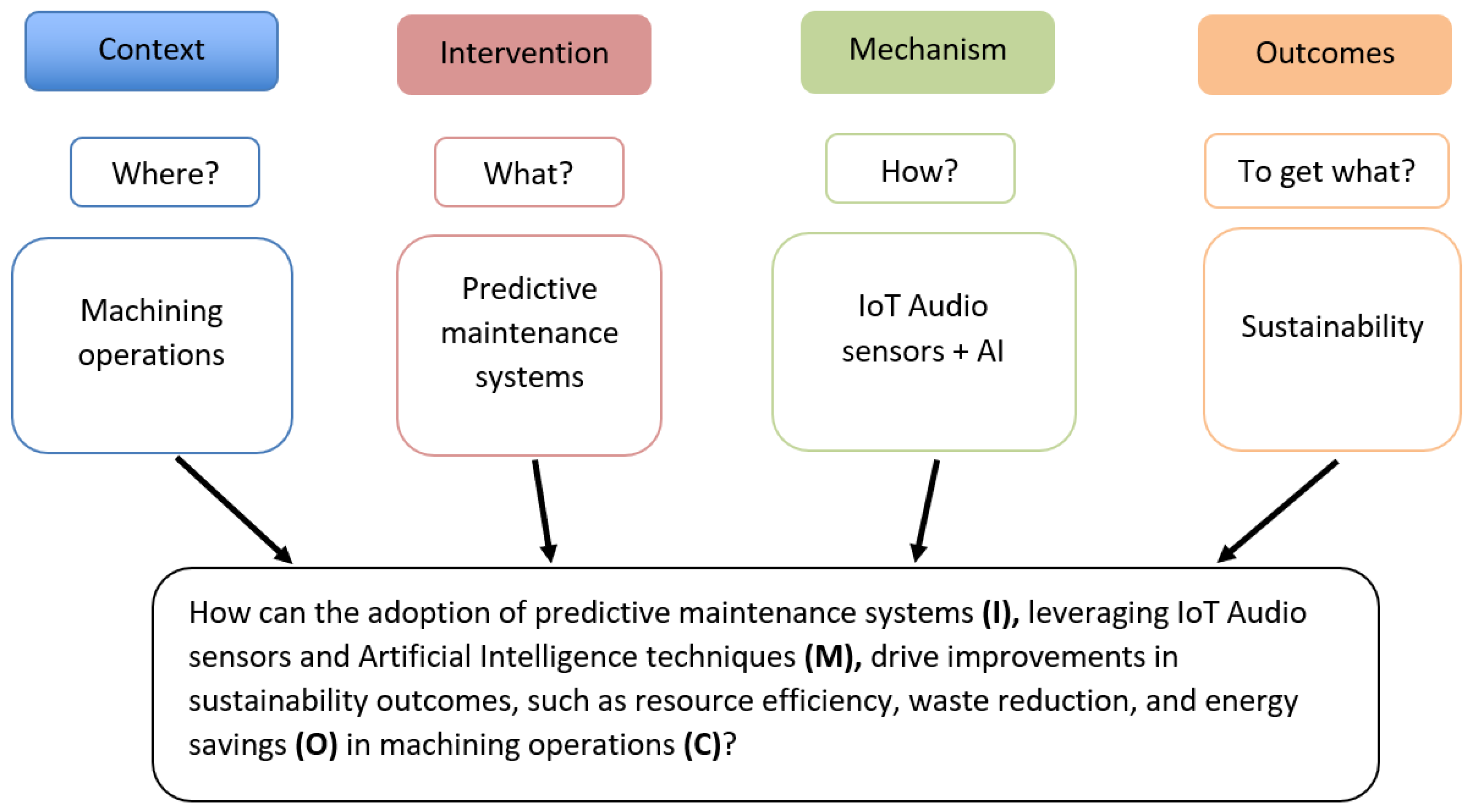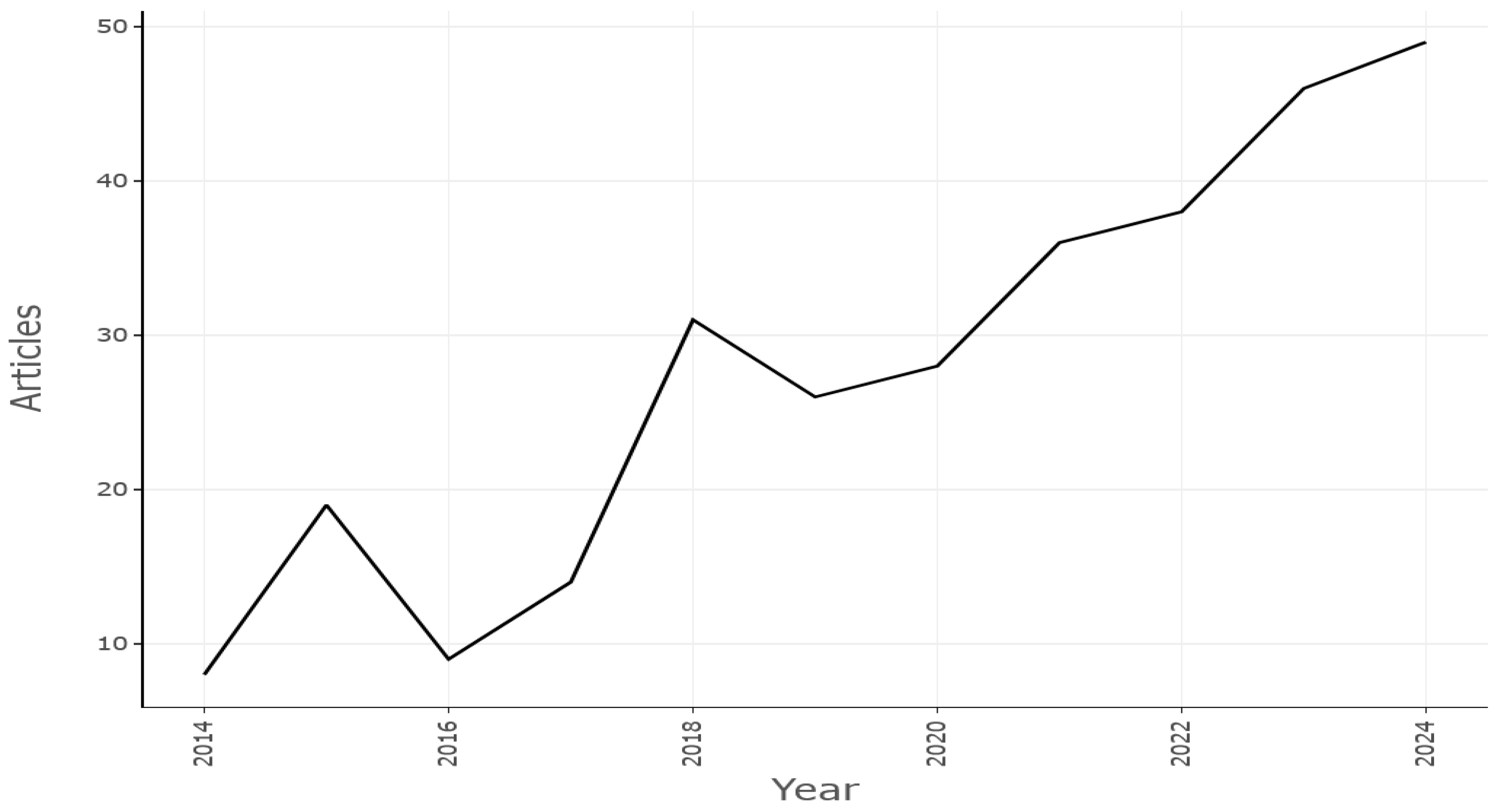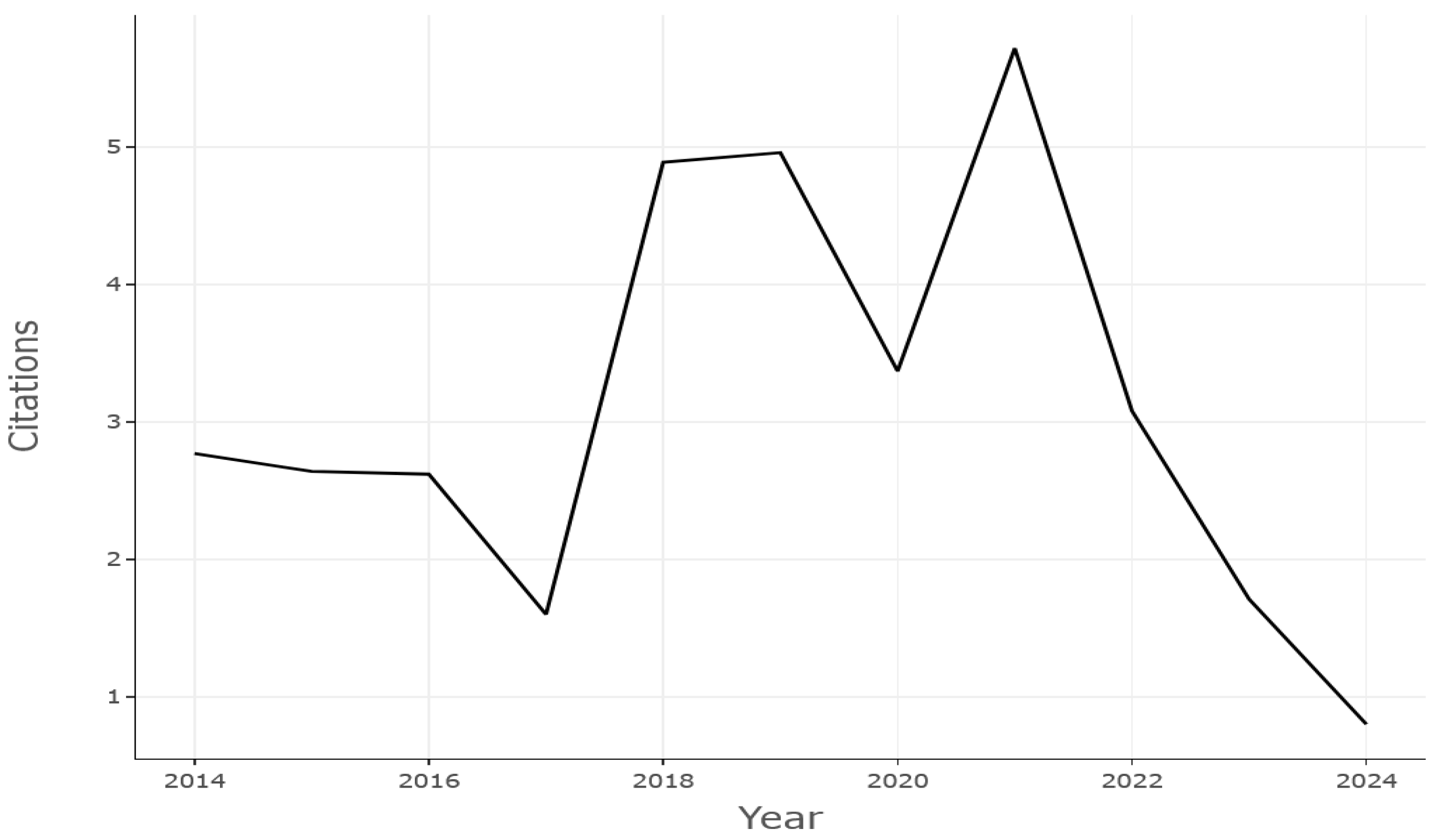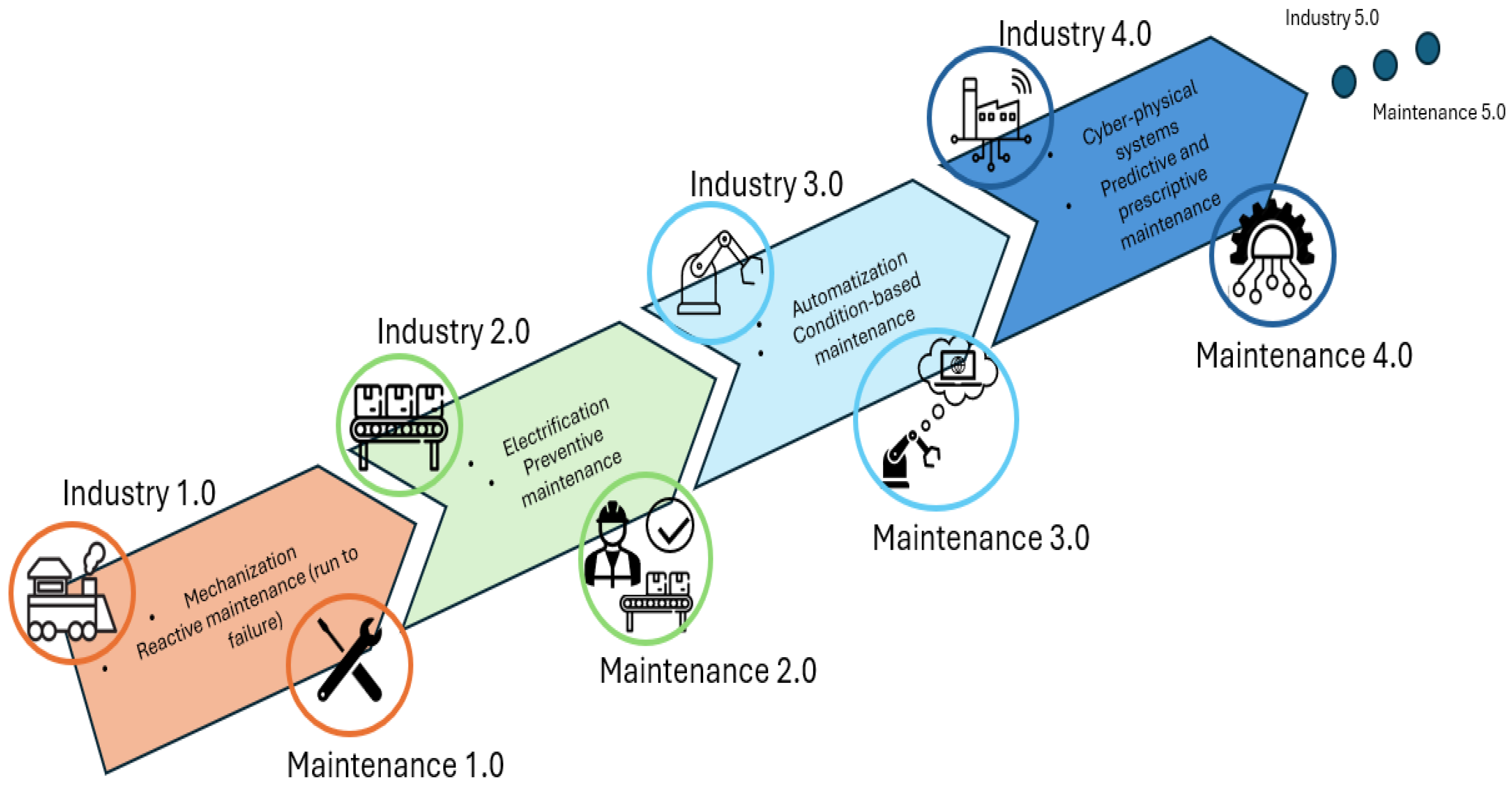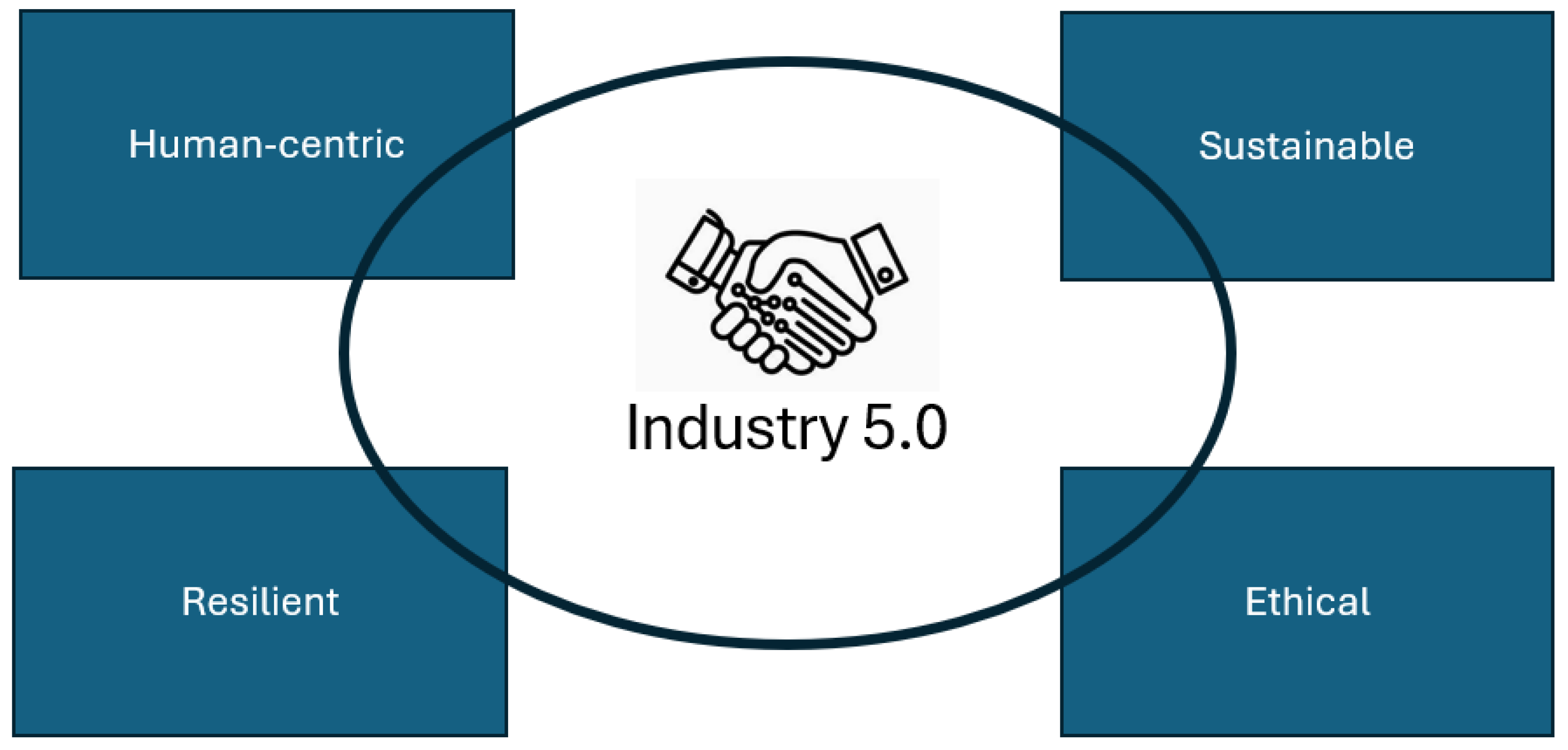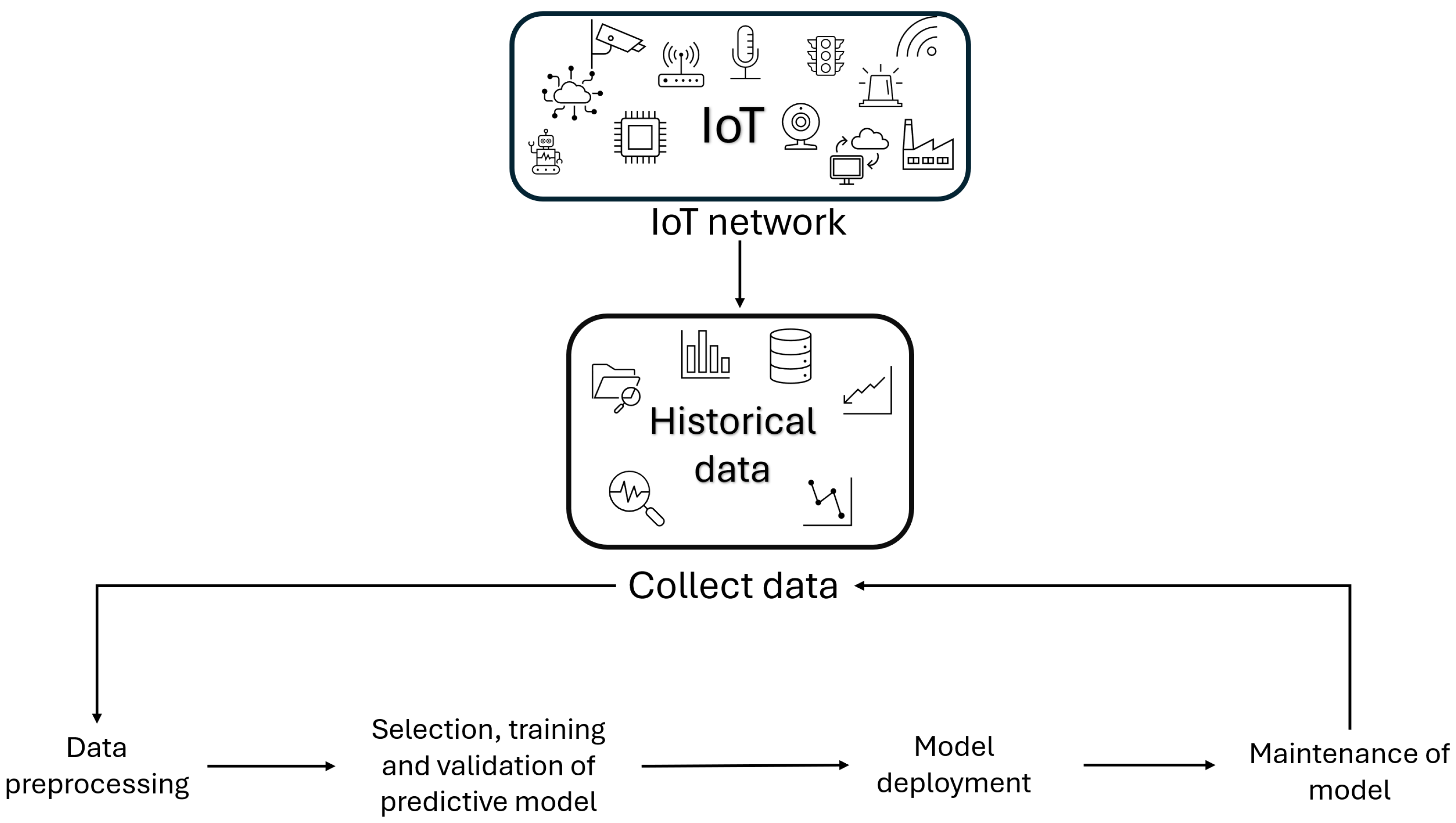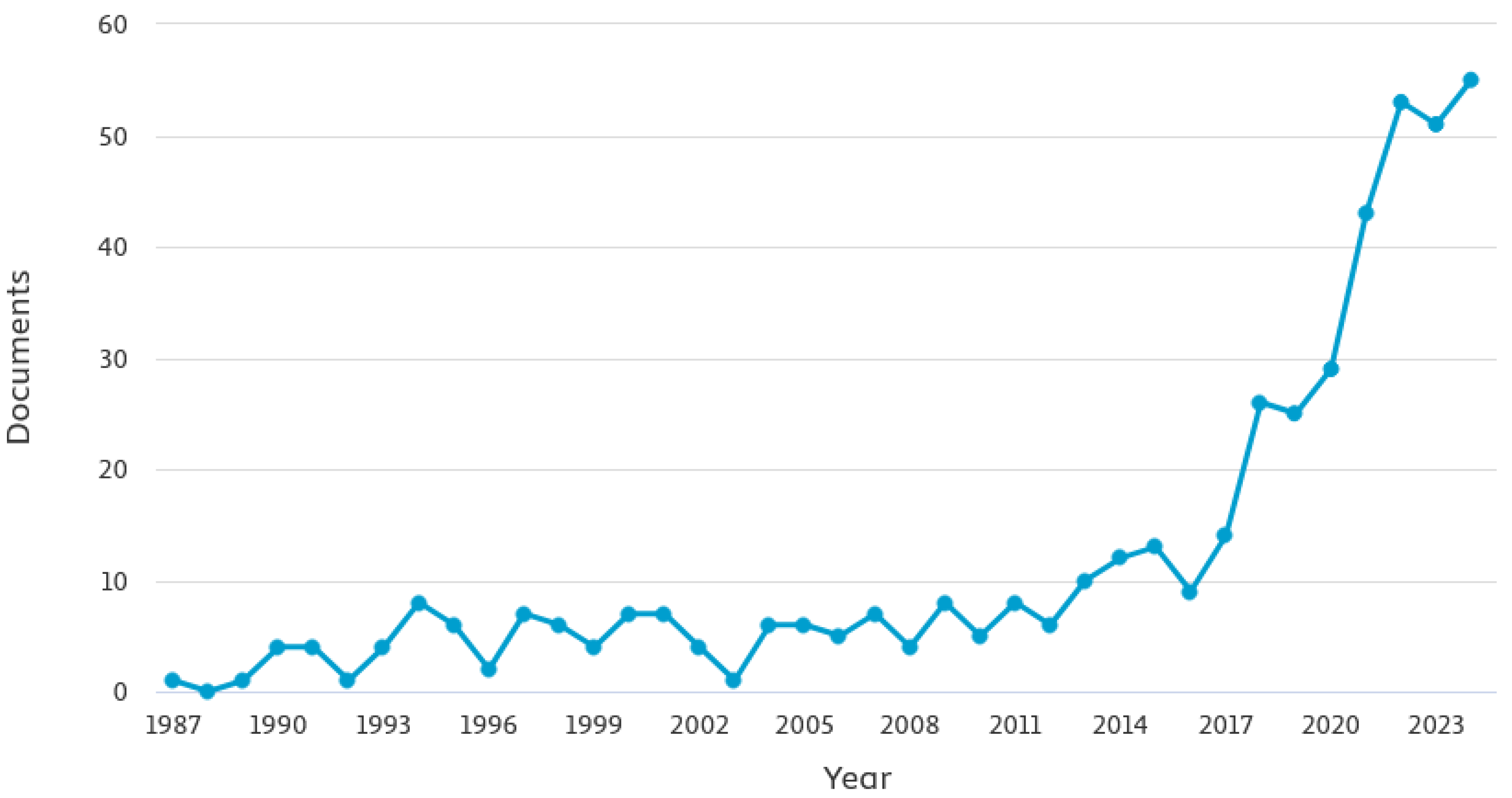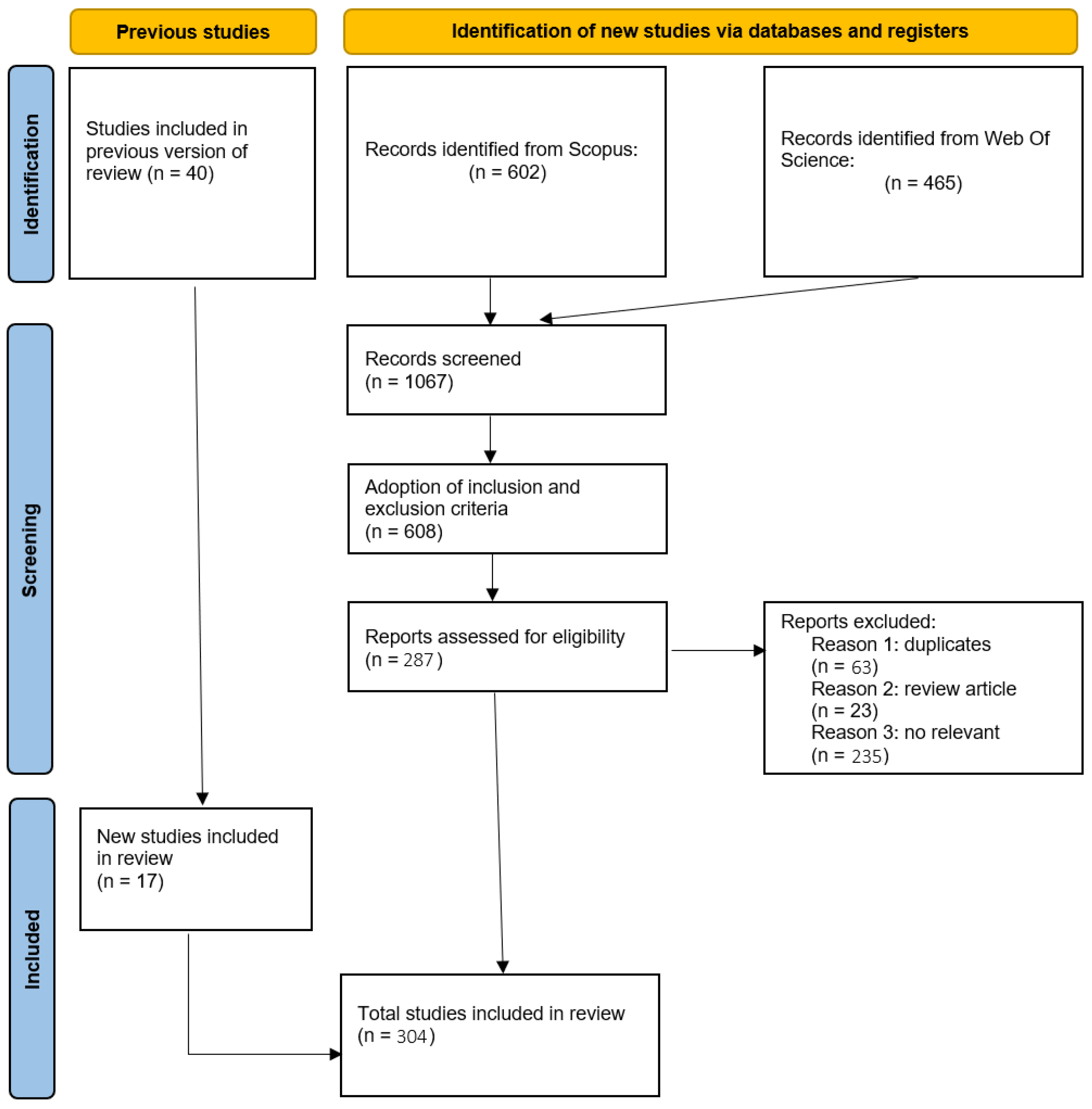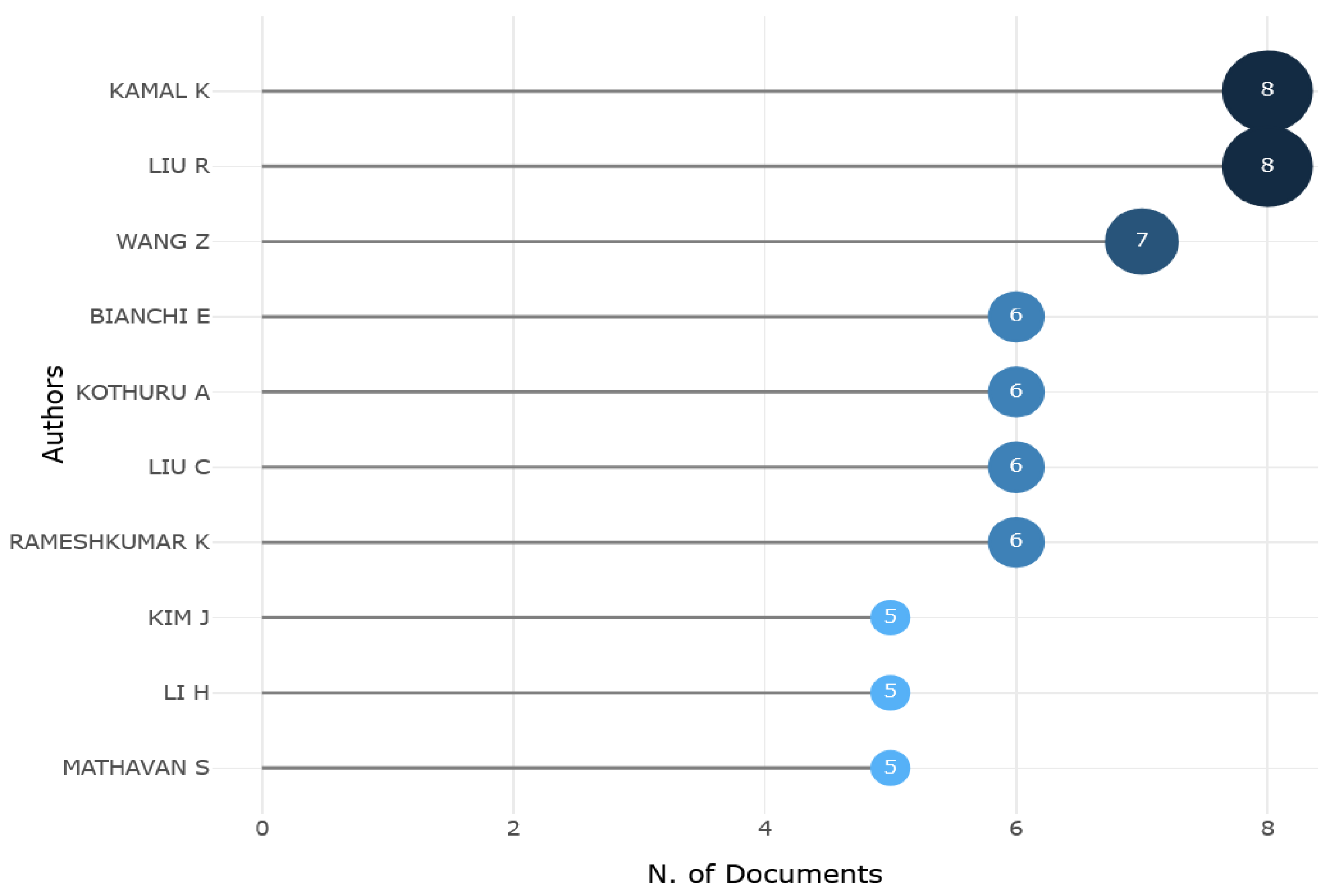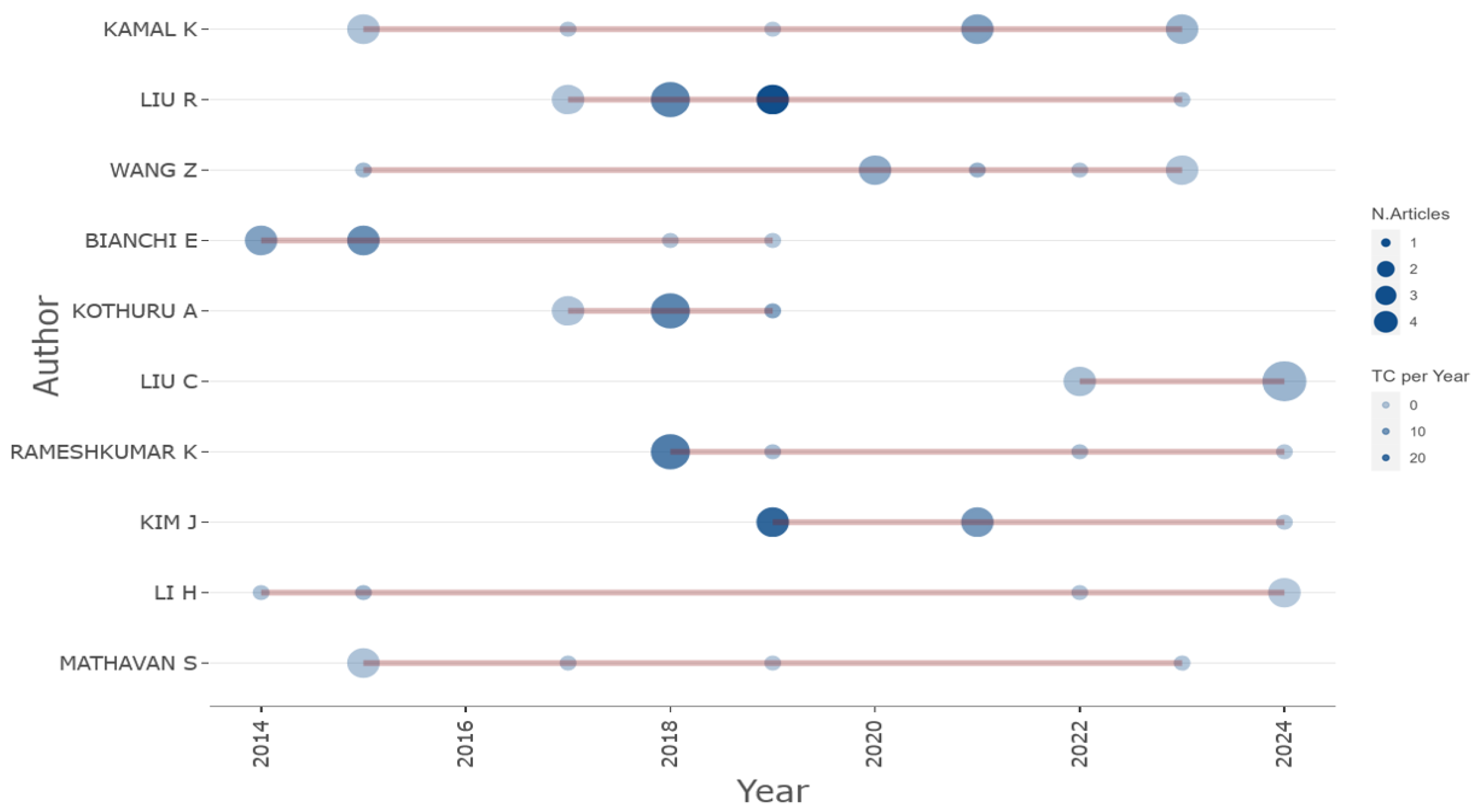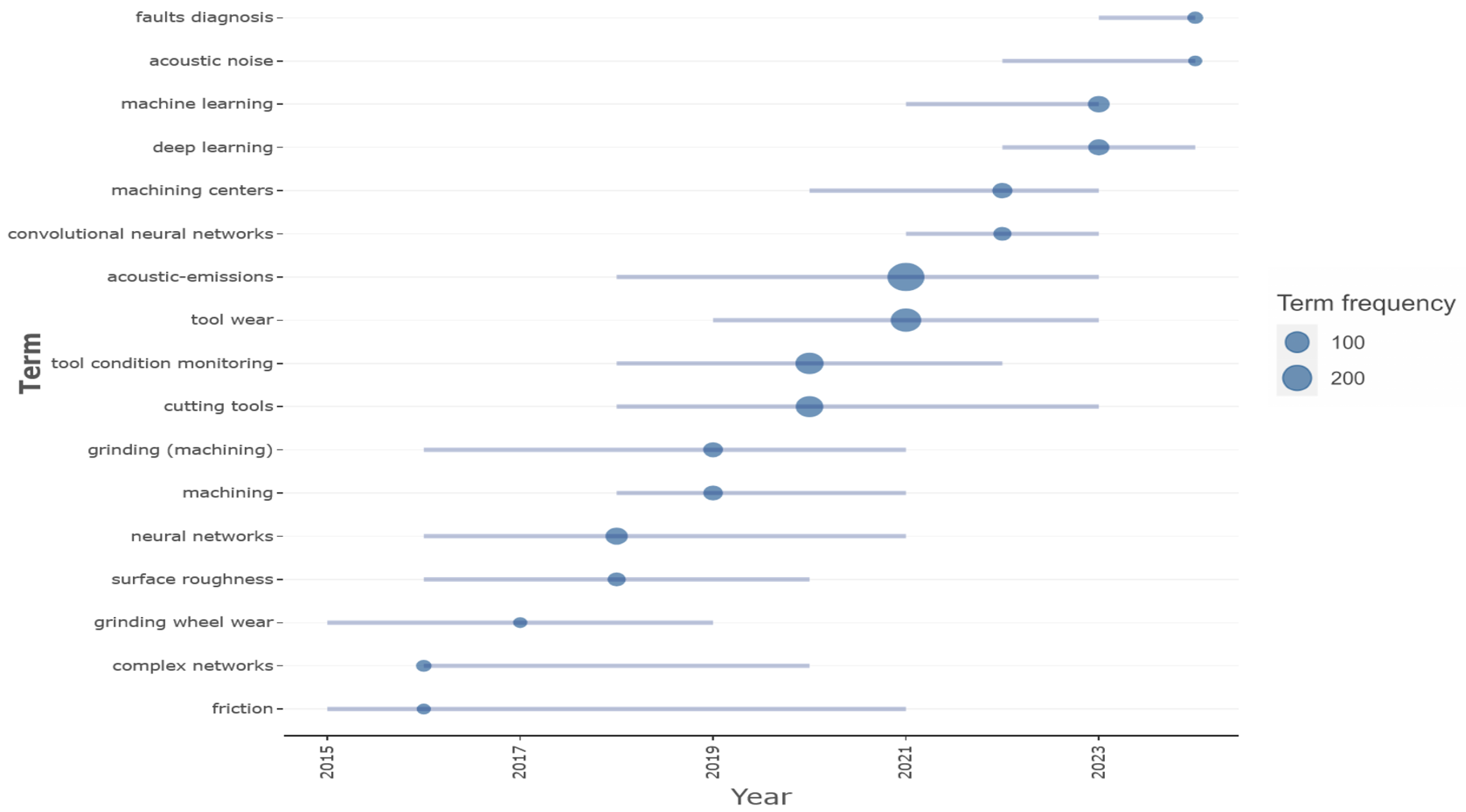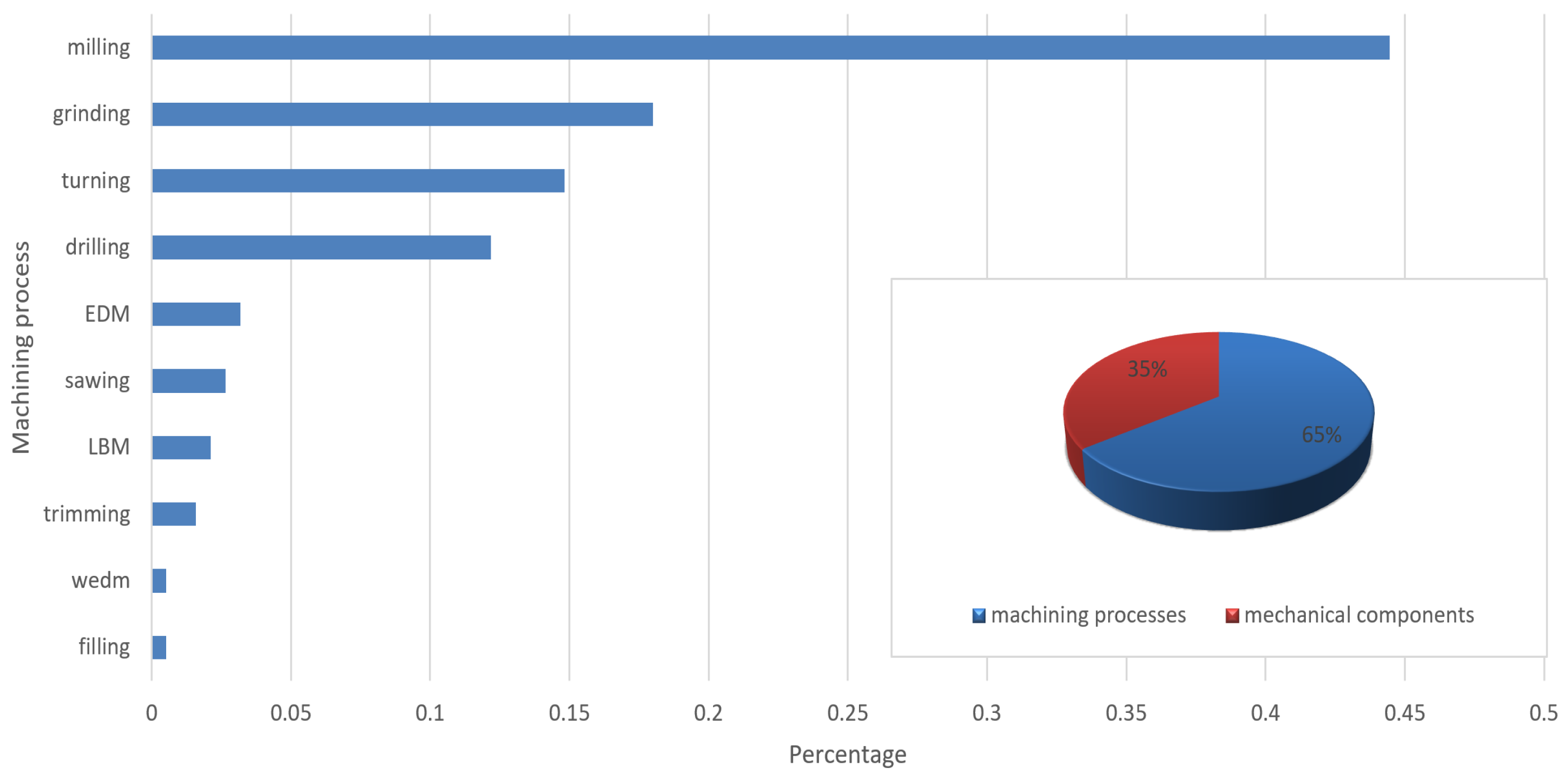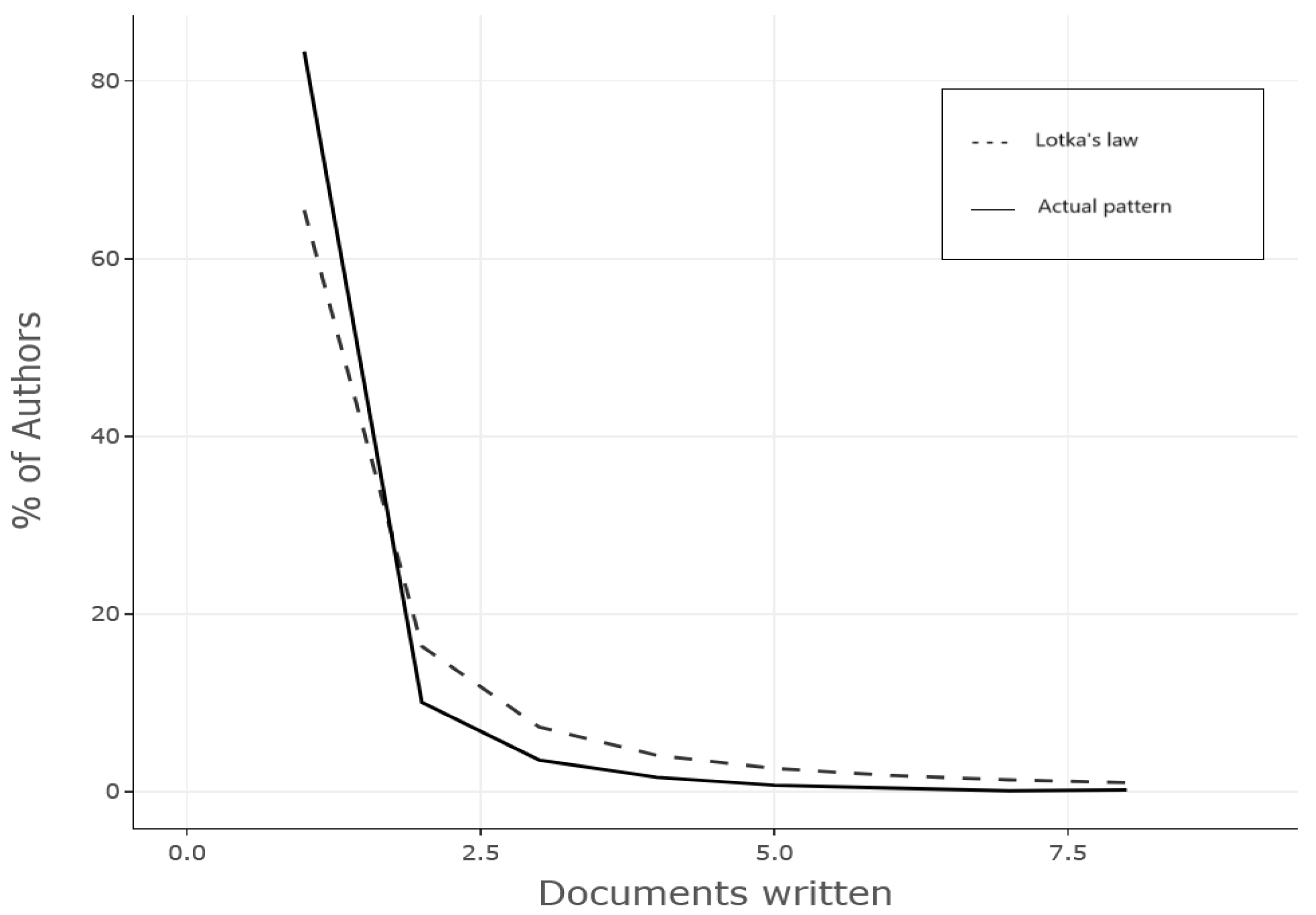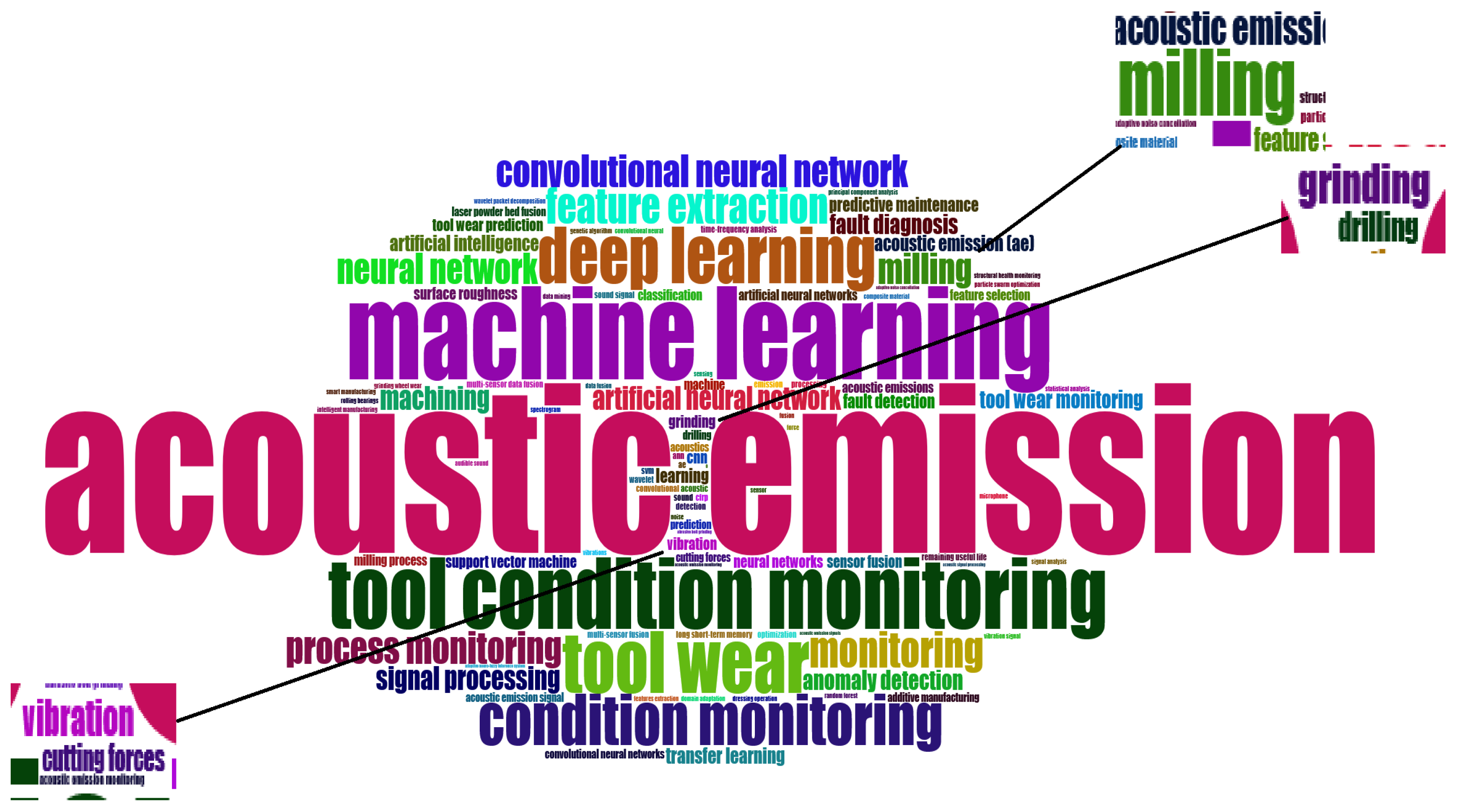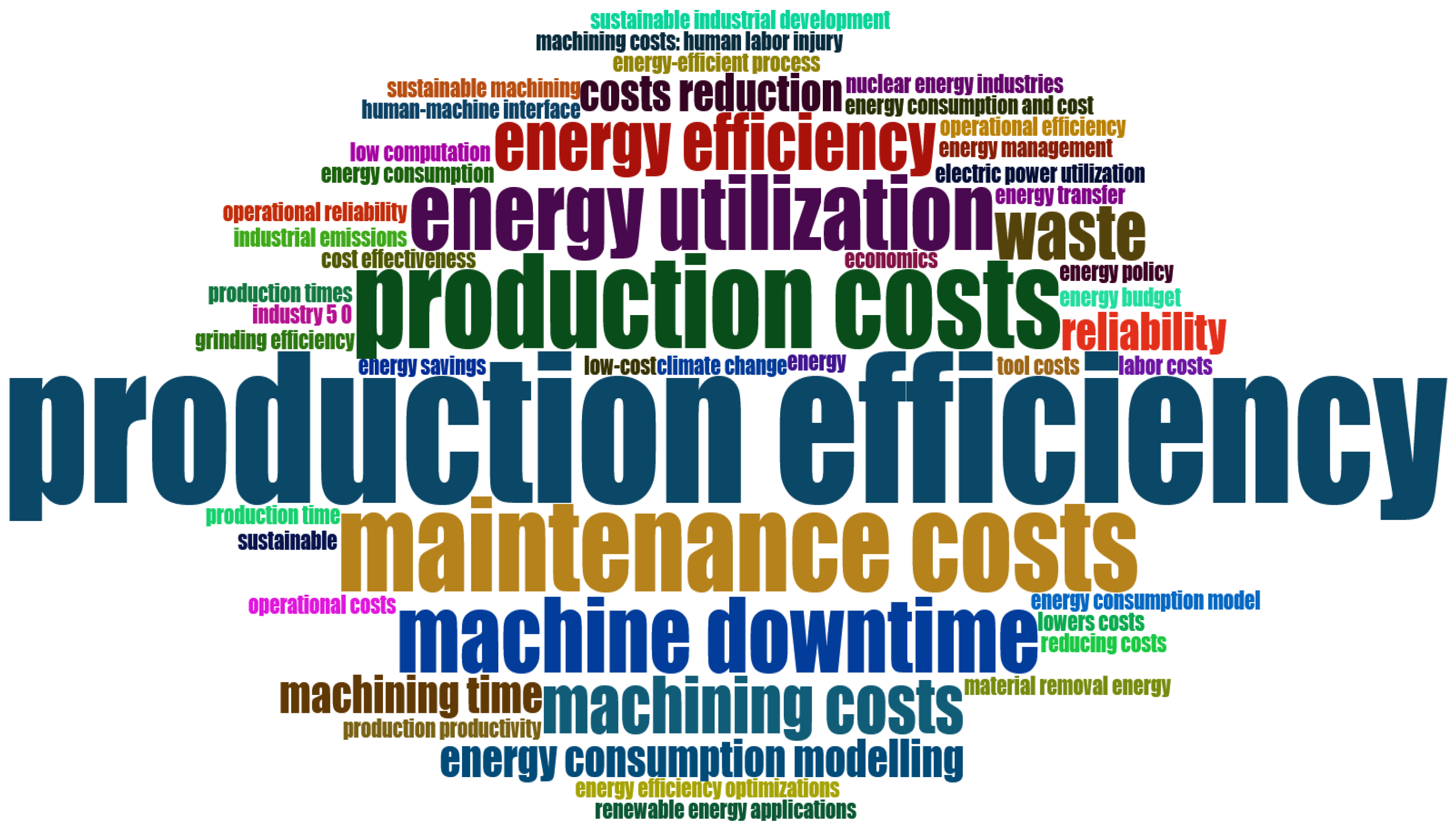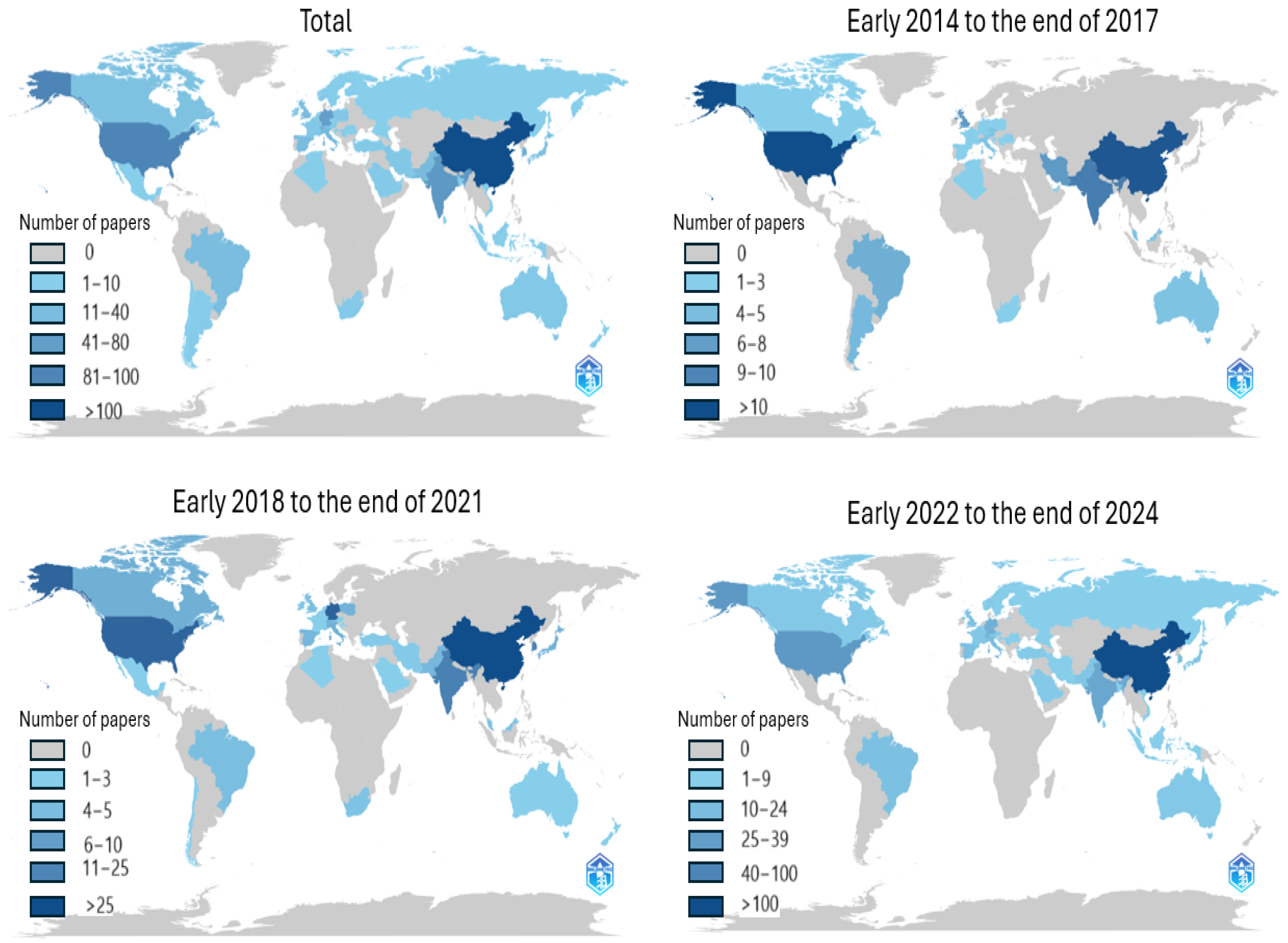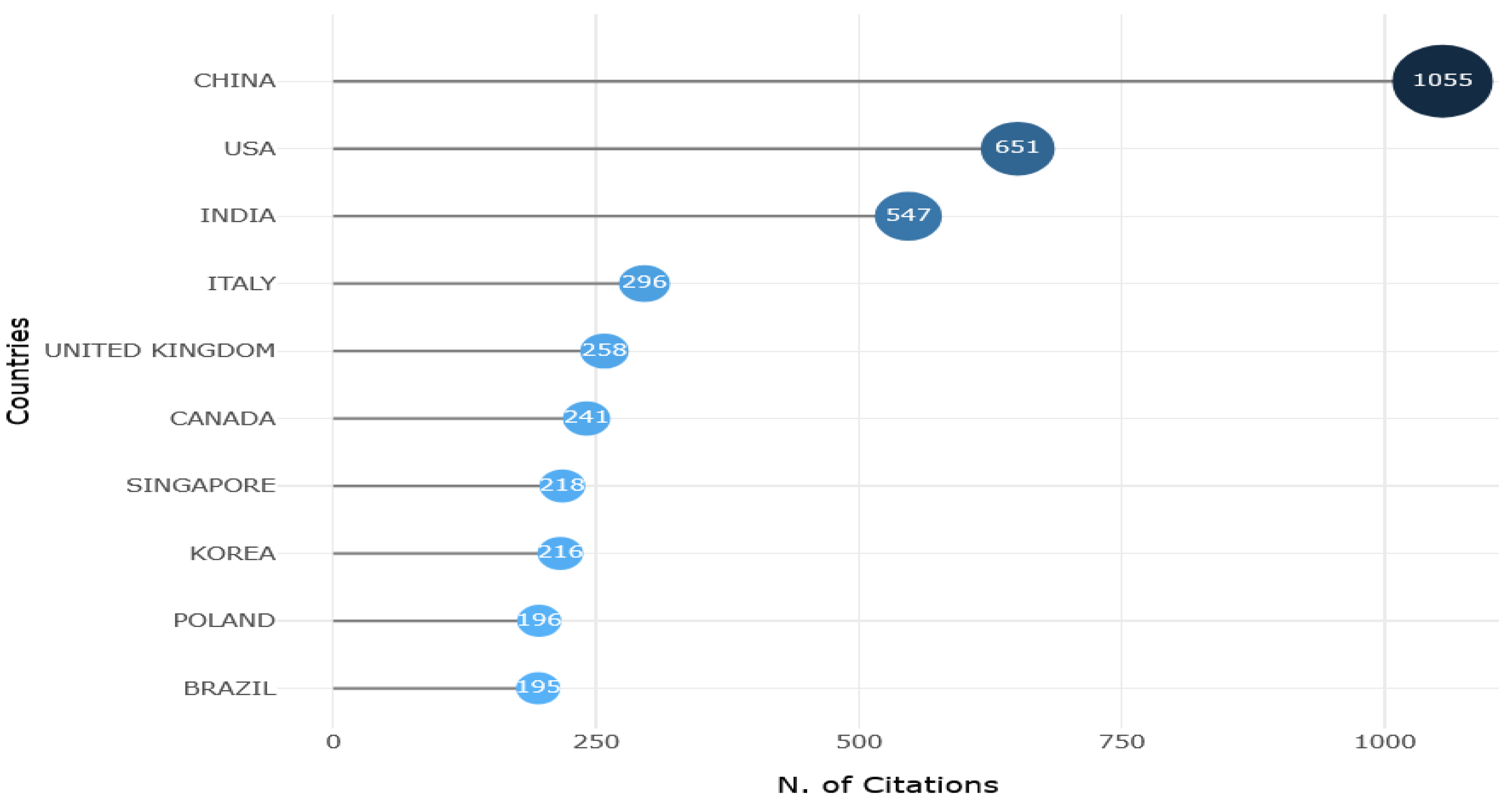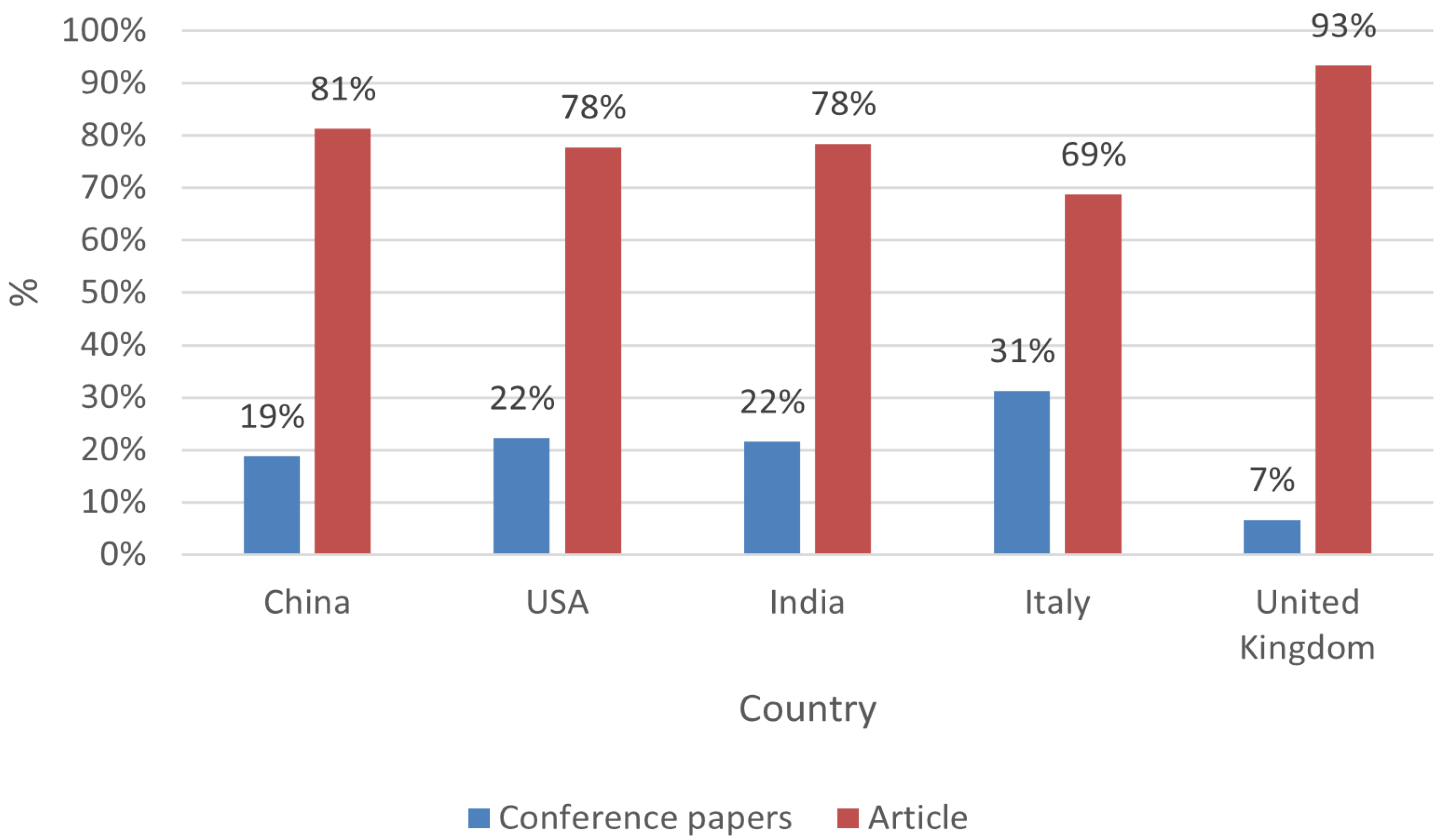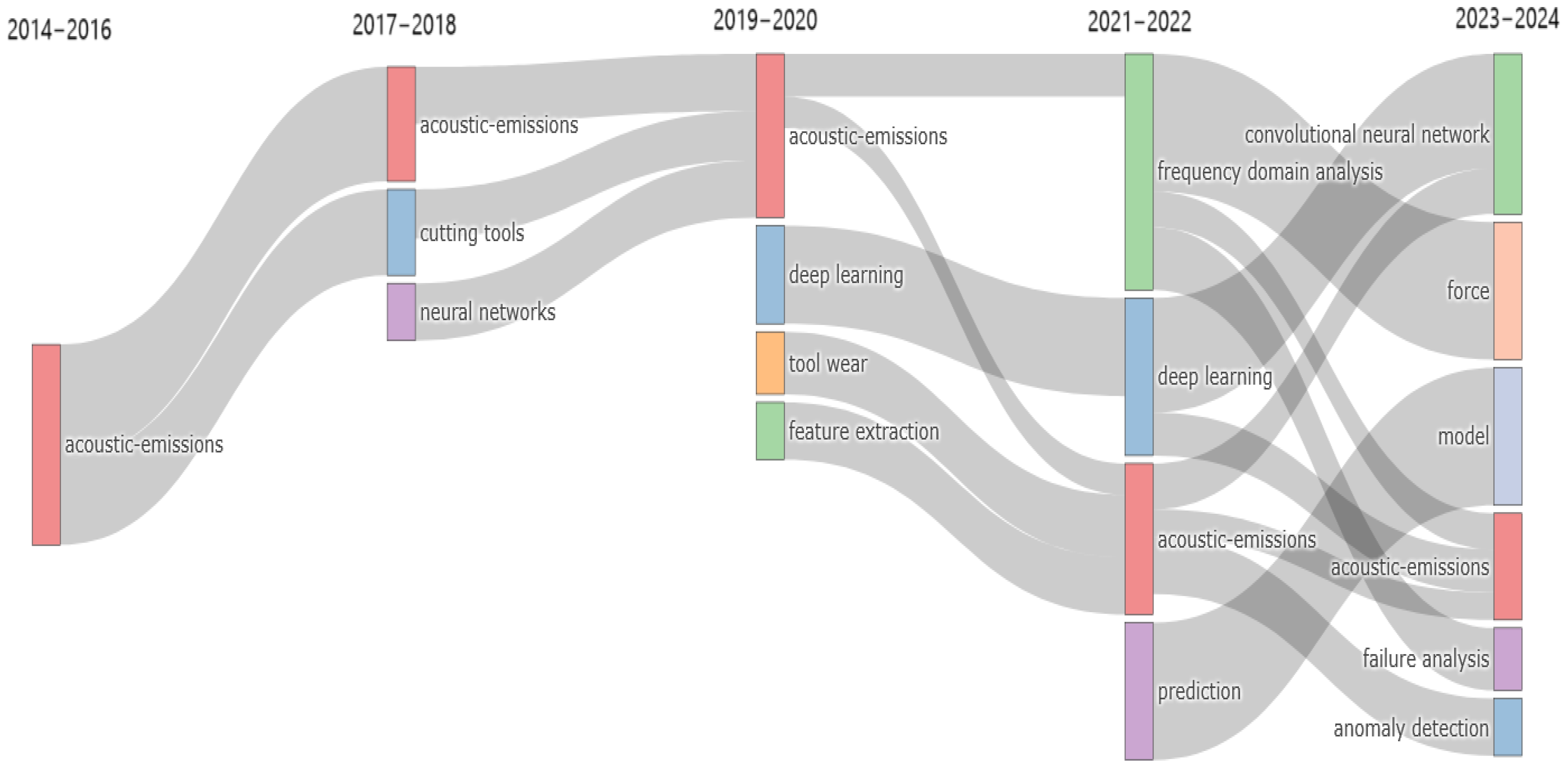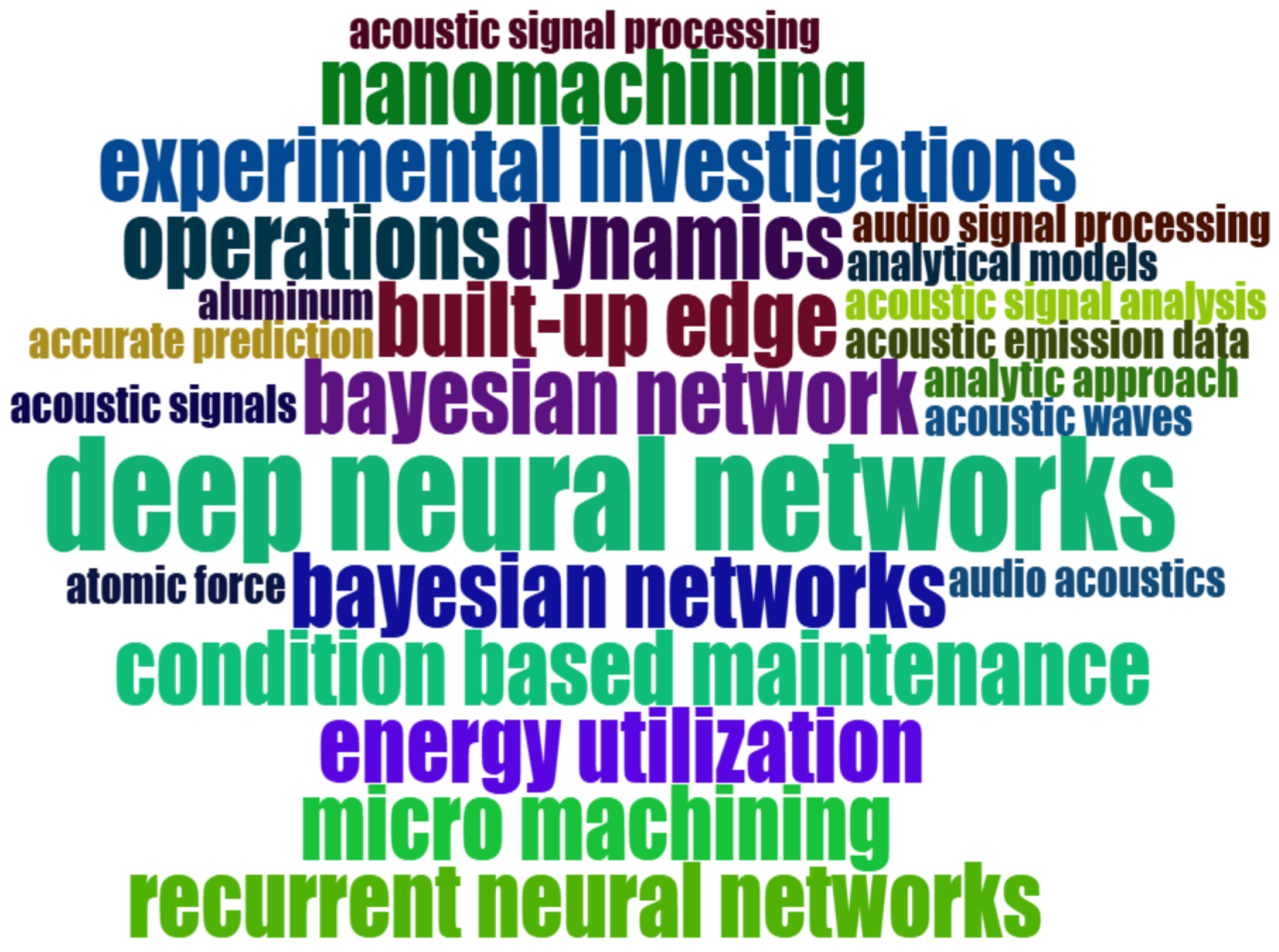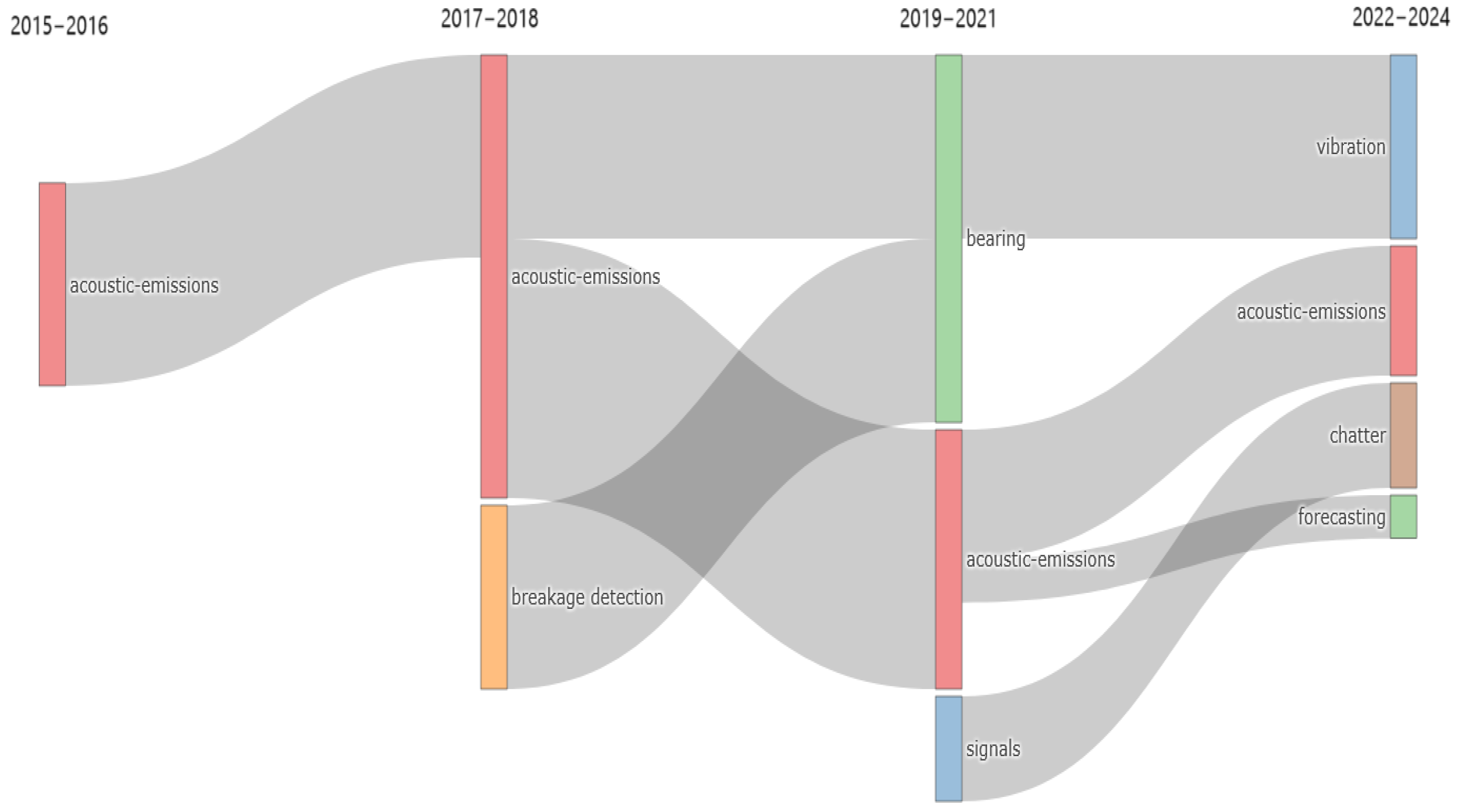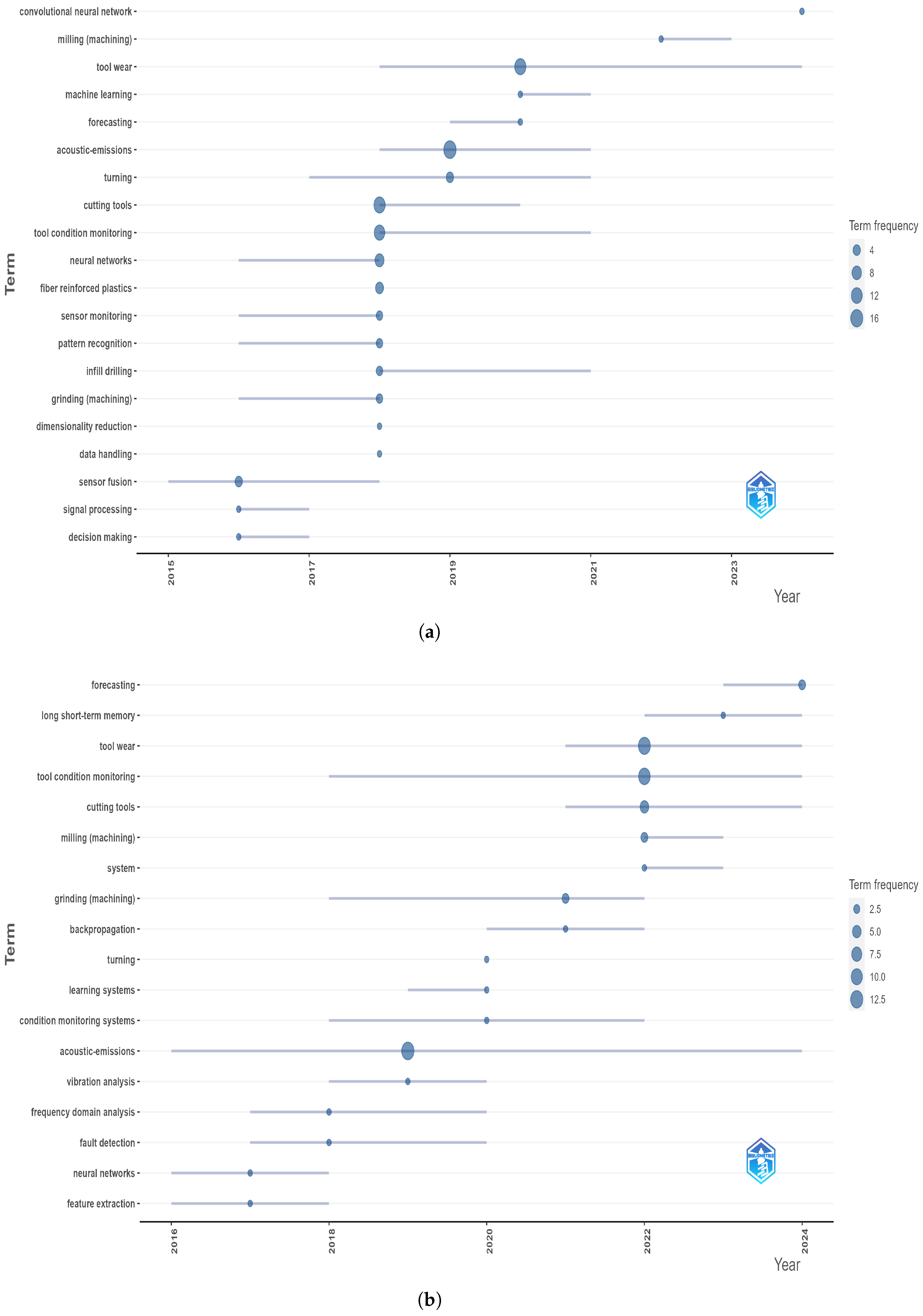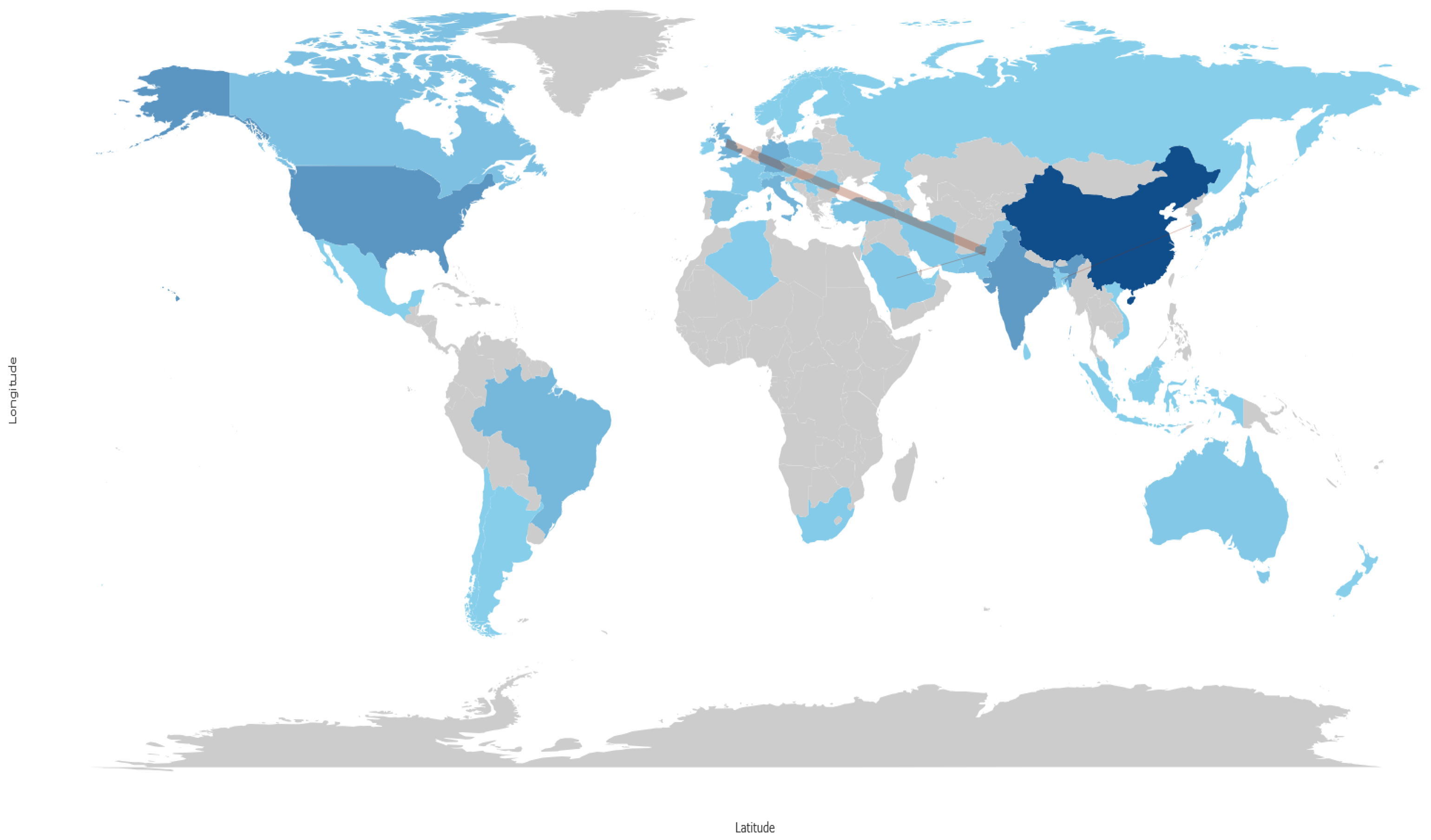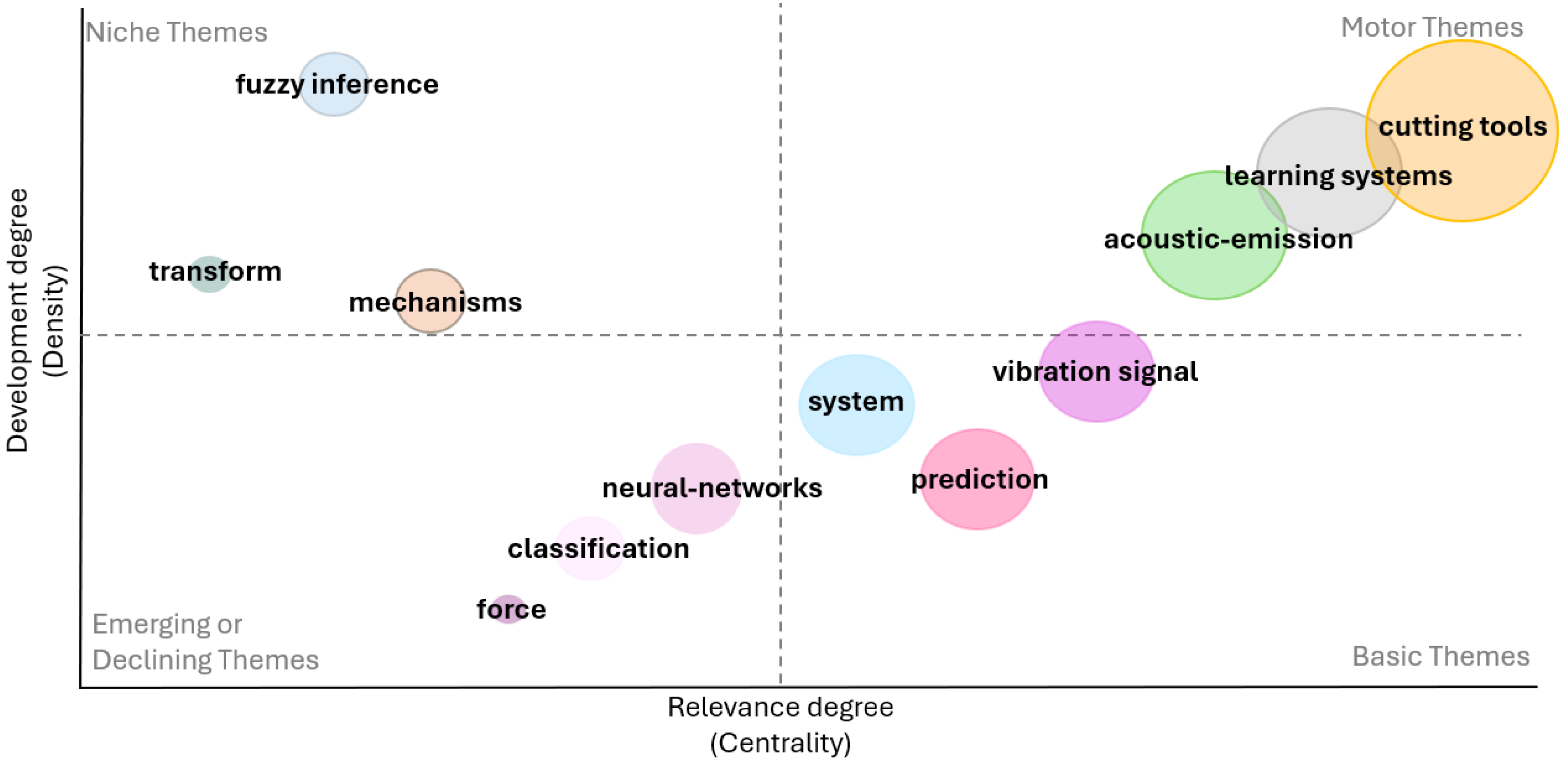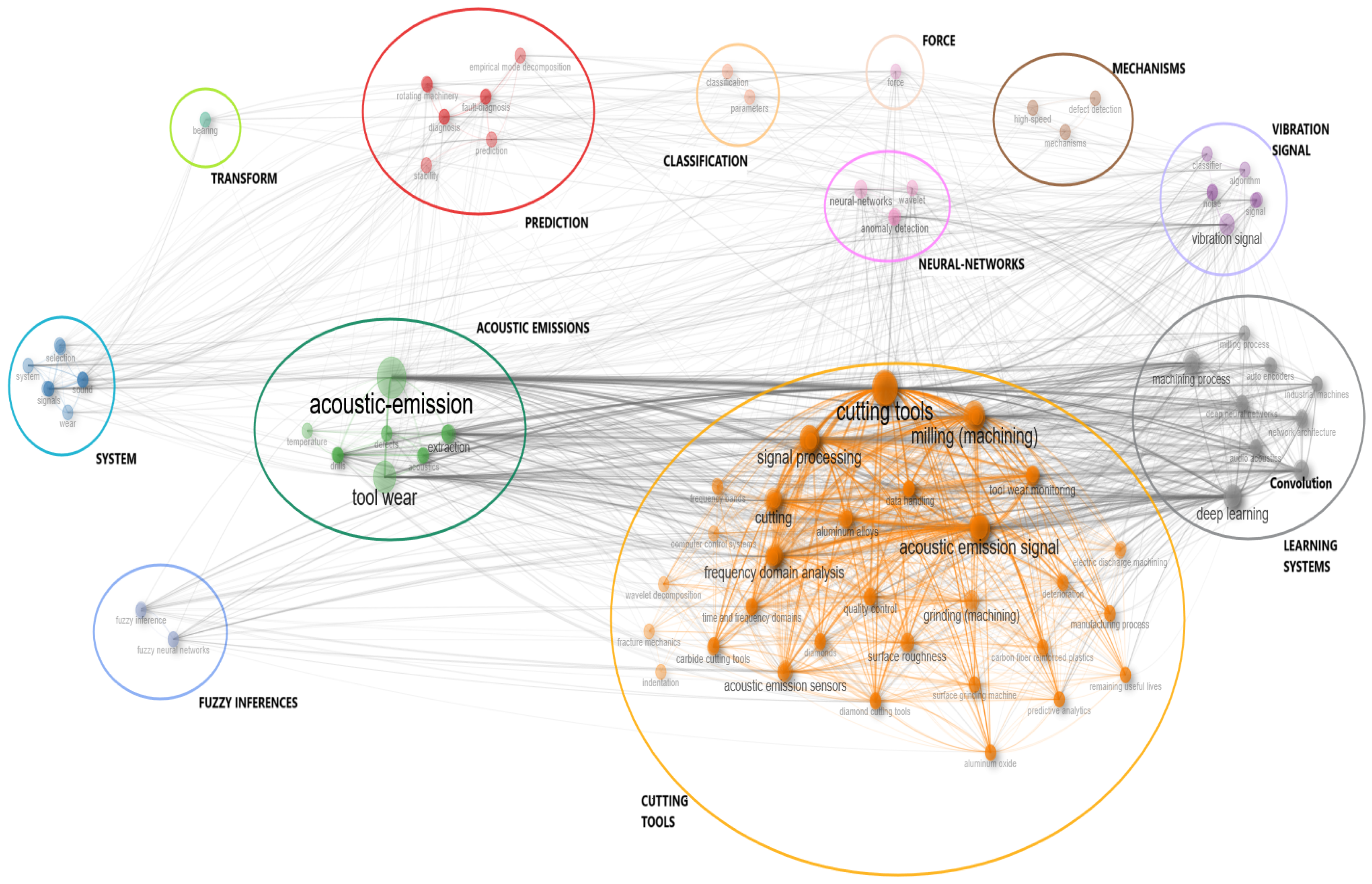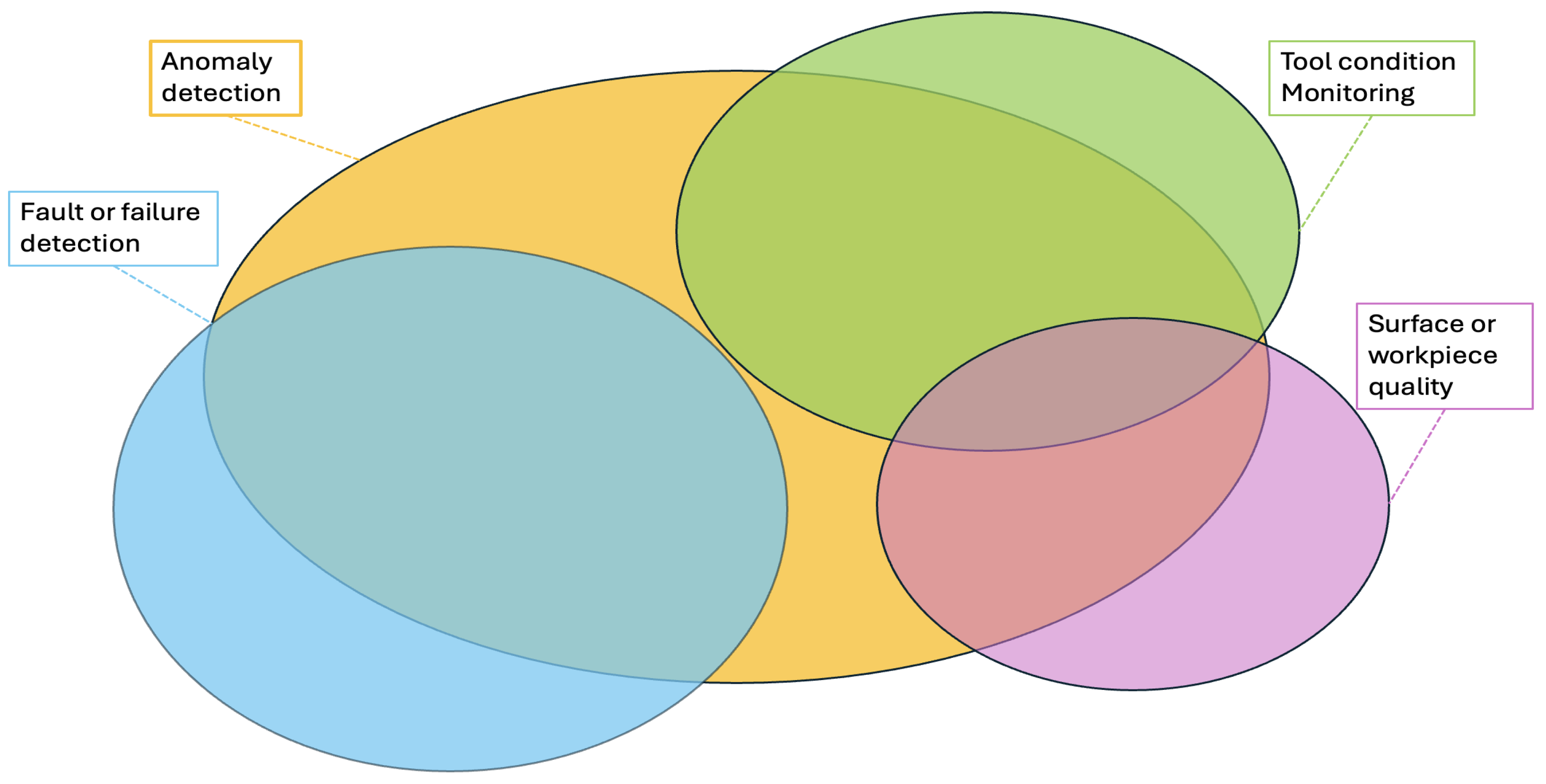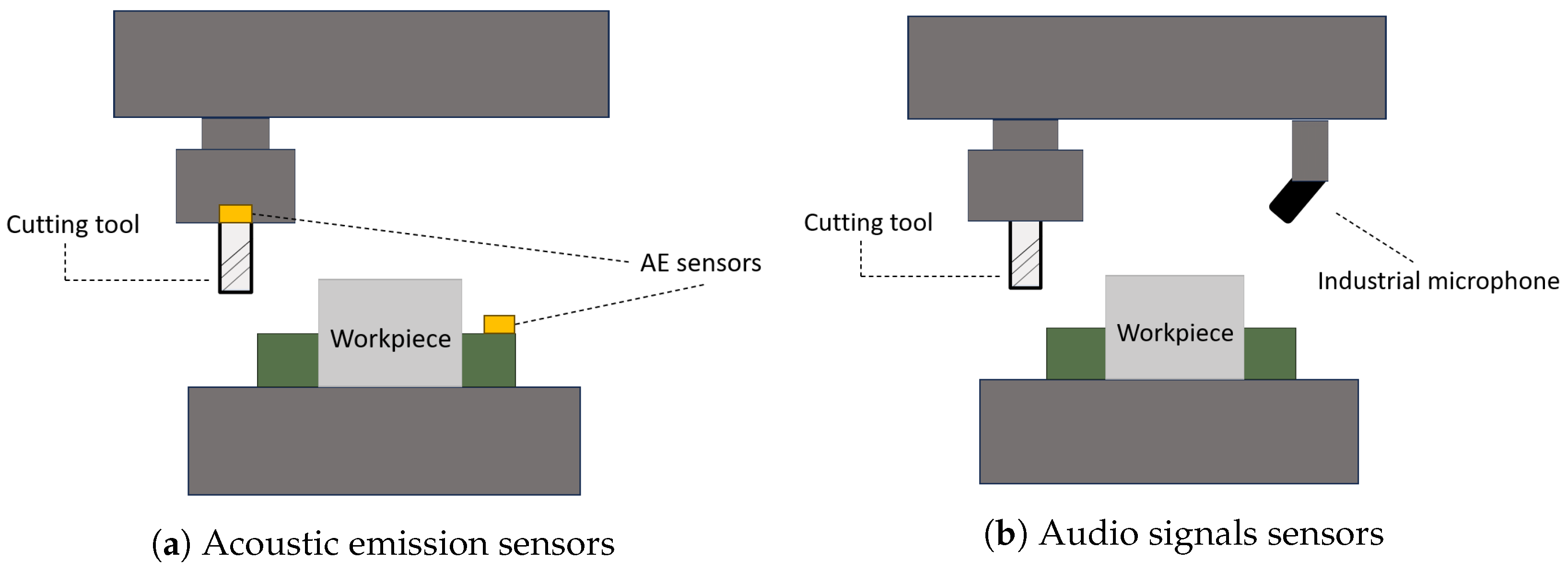1. Introduction
Sustainability has emerged as an important aspect of industrial processes. At a global scale, there is growing pressure to reduce carbon emissions from production; a challenge which is addressed by the simultaneous pursuit of enhanced energy efficiency, reduced waste, reduced costs, and increased process safety. With the advent of Industry 4.0, the integration of Internet of Things (IoT) sensors and Artificial Intelligence (AI) techniques had already begun to be employed to enhance manufacturing processes. This combination facilitated the monitoring, prediction, and identification of anomalies, contributing to improvements in production efficiency and, consequently, sustainability. Sustainable Manufacturing can be defined as the integration of processes and systems capable of producing high quality products and services using less and more sustainable resources (energy and materials), being safer for employees, customers, and surrounding communities, and being able to mitigate environmental and social impacts throughout the whole life cycle [
1]. The implementation of sustainable manufacturing practices is based on the recognition that businesses and industries must operate in harmony with the environment. This is achieved through the integration of sustainable manufacturing as a strategic imperative [
2]. In the age of Industry 4.0, with the use of modern smart technologies, manufacturing sustainability has evolved into a societal philosophy, and a dominant attitude for framing social, ecological, and ethical issues [
3], termed Sustainability 4.0. More recently, in the era of climate change and increasing global environmental challenges, the latest industrial evolution, named as Industry 5.0, marks a turning point, from an industrial approach that focuses on efficiency and automation, to a paradigm that prioritizes collaboration between humans and machines, innovation, and harmonization with the environment [
4]. This new paradigm has becoming a core enabler for achieving sustainable development and green growth in manufacturing.
García-Muina et al. [
5] introduced a sustainability-focused business model canvas for an Italian ceramic tile company. Based on data collected through sensors and meters invested in by the company, their new business model enables the adoption of sustainable practices, including the reuse of consumed water, within the company’s value creation strategy. Furthermore, it suggests the implementation of other sustainability practices, in accordance with the sustainable transition of all enterprises.
The use of IoT-wearable devices allows enterprise to increase their work safety level, performing four different functions [
6]: monitoring workers’ vital and environmental parameters [
7], enabling communication [
8], supporting training of workers using virtual and augmented reality [
9], and tracking workers’ positions to prevent accidents [
10,
11]. In addition, Predictive Maintenance (PM) represents a transformative application of IoT in industrial settings. IoT devices and sensors can help predict when equipment is likely to fail, enabling proactive maintenance to prevent accidents caused by faulty machinery [
12]. This approach minimizes downtime, reduces maintenance costs, and enhances worker safety by identifying and addressing issues before they escalate. The integration of PM with IoT has dual perspectives: it aligns with the goals of sustainability, and highlights the importance of advancing safety and operational efficiency across industries.
The implementation of a data-driven PM solution has attracted significant interest in modern manufacturing. Mallioris et al. [
13] provided a systematic review of PM applications across industries, including machinery, transport, energy, chemicals, pharmaceuticals, and electronics. A decision support map was provided, with the aim of guiding researchers and technicians in the construction of PM applications for each respective industry, by suggesting common input features, methods/algorithms, and software tools. Joshi and Sharma [
14] conducted an examination of the applications of Machine Learning (ML) algorithms in the context of low-carbon smart manufacturing, highlighting their role in integrating sustainable practices. The implementation of these advanced technologies, such as ML and Deep Learning (DL) algorithms, requires the collection of real-time data from the manufacturing processes. The integration of IoT devices and sensors facilitates the establishment of a connection between machines and algorithms, enabling the collection of real-time data from the four distinct product life cycle stages, namely supply, production, use, and end of life [
15]. This, in turn, enables enhanced decision-making processes, leading to improvements in operational efficiency and the sustainability of manufacturing processes. Data collected during production can facilitate predictive maintenance by continuously monitoring the health of machines and equipment [
12] and the quality of the machined parts [
16].
In Industry 4.0, sustainability has reshaped smart manufacturing, giving rise to Maintenance 4.0 [
17] (also called Smart Maintenance), evolving from the reactive Maintenance 1.0 to the predictive and perceptive Maintenance 4.0 [
18]. Maintenance 1.0 relied on operators fixing simple machinery faults as they occurred. Industry 2.0 introduced more complex machinery, necessitating dedicated maintenance departments for preventive care and inspections. The advent of automation has precipitated a concomitant shift in maintenance strategies, with the implementation of condition-based maintenance (or Maintenance 3.0), becoming the dominant paradigm. In this novel paradigm, maintenance models are constructed on the basis of collected and analyzed data, with the subsequent generation of recommended maintenance actions, predicated based on the specifics of the situation. Finally, with the advent of Industry 4.0, the use of IoT devices and sensors and the prominence of sustainability concepts evolved into the Maintenance 4.0 paradigm, in which maintenance becomes an enabler for the smart factory [
19], by predicting future failures and prescribing efficient preventive actions. As Industry 5.0 emerges, maintenance must align with its core principles, progressing toward Maintenance 5.0. The progression of maintenance paradigms as the industry advances is illustrated in
Figure 1.
The transition to the new Industry 5.0 paradigm has defined modern organizations, demonstrating a shift and increase in focus, towards ethical engineering principles [
20]. It has introduced new views of sustainability, such as social, which focus on the well-being of operators. Therefore, the use of smart machines equipped with sensors is becoming essential for the construction of automated tools capable of reducing the pressure on operators in managing emergency situations such as extraordinary maintenance. All maintenance efforts in this paradigm are guided by the four values of Industry 5.0, as illustrated in
Figure 2.
This literature analysis has highlighted the maintenance-related impacts on the three aspects of sustainability: environmental, economic, and social [
17,
18].
Table 1 provides a summarization of these impacts.
All these positive impacts can be achieved by combining IoT devices and/or sensors and ML or DL techniques to implement a Maintenance 5.0 strategy. Furthermore, the costs associated with IoT monitoring systems can be onerous for companies, especially small- and medium-sized enterprises [
21]. For these companies, the initial investment for IoT infrastructure can be prohibitively expensive [
22].
The implementation of an IoT network that has been customized for industrial processes is a prerequisite for the subsequent application of ML or DL techniques to sensor data to formulate a predictive maintenance strategy. This process is characterized by four distinct stages [
23], as illustrated in
Figure 3. The first stage consists of the selection of historical data, collected through sensors. Subsequently, the selected data must be pre-processed, in order to transform them into an appropriate form for the next stage, in which a predictive model is constructed to recognize future failures. Finally, there is the maintenance stage of the model, in order to maintain the performance of the model over the long term, and the acquisition of new data.
In the domain of machining operations, the most frequently used sensors are the following: accelerometers, which are utilized for the acquisition of vibrations; dynamometers, which are employed for the measurement of cutting force; and microphones, which are used for the purpose of recording audio [
24]. To construct PM systems at minimal financial cost, microphones may be the most cost-effective sensor to employ. Given this advantage, combined with the demonstrated prediction performance of a system based on audio signals for predicting future failures in an industrial setting, interest in this field has grown rapidly in recent years, as shown
Figure 4.
This growing interest has led to the publication of numerous works exploring vastly different directions, making it challenging to identify or develop an adequate solution for practical applications. Different maintenance-related standards have been identified from organizations such as the International Standards Organization (ISO) and American National Standards Institute (ANSI). In the literature, a wide range of factors, such as sampling rate, microphone positioning, and cutting parameters, have been considered, leading to varied results and approaches.
This review article aims to provide a comprehensive overview of the research conducted in the field of predictive maintenance for machining operations, focusing on approaches that combine AI techniques with data acquired from sensors, particularly through the use of microphones for capturing audio signals. The main objective is to ensure that researchers and enterprises gain a clear understanding of how audio signals can be leveraged for real-time monitoring, control, and optimization of industrial processes. Additionally, this review highlights the potential of predictive maintenance systems based on AI and audio signals, examining key applications such as anomaly detection for predicting anomalies during production, fault detection for forecasting machine failures, and tool condition monitoring (TCM) of the tools used in the process. Furthermore, the review will assess which of the different machining processes scientific research is focusing. By clarifying the various applications and settings analyzed in existing research, this article aims to provide a clearer picture of the current state of the field and offer guidance on the direction of future research in predictive maintenance.
The rest of this article is organized as follows:
Section 2 provides a detailed explanation of the methodology adopted for the selection of the papers analyzed in this review work. The section is divided into four subsections, corresponding to the four phases of the PRISMA methodology. A further subsection relates to the formulation of additional research questions.
Section 3 presents the results of the analysis, while
Section 4 provides a discussion of the findings of this review work. Finally,
Section 5 provide the conclusions of the study.
4. Discussion
In this section, answers to research questions are discussed.
The main goal of this work was to provide a comprehensive overview of research endeavors centered on the development of predictive maintenance systems for machining processes, with a view to enhancing sustainability in accordance with the paradigm of Industry 5.0. Given the significant interest in this field, the present review focused on an analysis of studies related to the use of audio signals or acoustic emissions for the monitoring of machining processes. The decision to focus on these sensors was driven by the premise that they offer a cost-effective alternative to commercially available sensors, thus aligning closely with the sustainability objectives of the Industry 5.0 paradigm.
The present work aims to address a gap in the extant literature by providing an effective overview of the state of the art regarding the use of these sensors to improve machining processes. The high scientific interest in this field is evidenced by the publication of numerous review works, which have analyzed the use of sensors in general in some works, and more specifically the acquisition of audio signals or acoustic emissions in others. However, these works have focused on a single specific machining problem.
Kasiviswanathan et al. [
76] examined papers pertaining to the utilization of sensors in conjunction with ML methodologies for the development of a predictive model for the issue of TCM in CNC turning centers. The authors recognized the necessity of defining a non-disruptive solution for standard industrial CNC machines, to integrate sensors without compromising the CNC machine’s efficiency and safety. In addition, Pimenov et al. [
77] examined papers related to the TCM problem, in this case, for the milling process, and the authors recognized the high installation costs connected to the use of sensors like dynamometers or accelerometers to monitor the process. Conversely, they highlighted the necessity of combining sensors and ML techniques for the development of predictive systems in the context of sustainable manufacturing. Gawde et al. [
78] published a systematic literature review related to the development of predictive models for fault diagnosis of rotating machines, analyzing the use of several sensors. Wei et al. [
79] conducted a comprehensive examination of how ambient noise, specifically in high-speed cutting scenarios, impacts processing efficiency and accuracy. The review encompassed a detailed analysis of noise identification, signal acquisition, and noise processing methodologies employed in high-speed machining contexts. The study also examined tool condition and chatter detection works. However, it did not explore the integration of IoT audio sensors with advanced ML/DL techniques, nor did it address sustainability aspects that are crucial for Industry 5.0.
Our review aims to fill this gap by offering a bibliometric analysis and highlighting the evolution of the state of the art, emphasizing the convergence of intelligent audio sensing, AI algorithms, and green manufacturing strategies.
Table 9 presents the exhaustive literature review, which is organized according to area, keywords, and time frame.
Building upon these prior reviews, the present work seeks to provide a broader overview of the current state of the art regarding the use of cost-effective and easily implementable sensors, specifically microphones for audio signal acquisition. Unlike other sensor technologies, microphones offer a non-intrusive solution that does not require modifications to the structural components of industrial machines, making them an attractive option for widespread adoption in manufacturing environments. This characteristic aligns with the principles of sustainability within the Industry 5.0 paradigm, as it facilitates the integration of advanced monitoring systems without requiring significant economic or operational burdens on manufacturers. Nonetheless, as revealed by the analysis in
Section 3.3, the acquisition of acoustic emissions instead of audio signals was more frequently used in the literature. In any event, the utilization of audio signals or acoustic emissions, in conjunction with ML or DL techniques, has been demonstrated to be a more efficacious approach for the development of predictive models, with the objective of enhancing the sustainability of numerous machining processes. A powerful tool was obtained from this combination for the understanding of the erosion of the material in EDM [
84]. High prediction performance was obtained by testing a deep architecture constructed for music and sound detection on a machine diagnosis dataset [
85]. An efficient balance between accuracy and computational resource usage was demonstrated by testing a simple neural network for tool wear prediction in a milling process [
66]. The scientific literature has demonstrated that the adoption of predictive maintenance systems, leveraging IoT audio sensors and AI techniques, can lead to improvements in sustainability outcomes for machining operations. These outcomes are achieved by addressing various industrial problems, including tool condition monitoring, fault diagnosis, and surface quality.
The analysis of the selected papers suggests that there is some variability in how problems are classified across different studies. In particular, certain distinctions between problem types are not always explicitly stated, and terminology may sometimes overlap or be used in a broad sense. This variability can make it challenging to precisely identify individual contributions and, in turn, to trace the progression of the field. As illustrated in
Figure 26, many studies refer to anomaly detection; however, the term is sometimes used in the context of fault detection, while in other cases, it relates to TCM or surface quality issues. Additionally, there appears to be a notable interplay between TCM and surface quality. Some authors consider TCM the primary problem, as tool wear or suboptimal machining parameters directly affect surface quality. However, other studies addressed the issue by predicting the final quality of the workpiece, modeling parameters such as surface roughness based on tool life and machining conditions. This ambiguity in terminology and problem definition hinders a clear understanding of the field’s evolution. Therefore, it is crucial to establish a rigorous and consistent classification framework to facilitate comparisons between studies and support the scientific community in tracking advancements in the discipline.
Furthermore, the bibliometric analysis conducted in this study has also provided answers to the additional research questions formulated in
Section 2.5. Specifically, it has helped to elucidate.
RQ1: What are the most common sustainability-related keywords and concepts linked to predictive maintenance in machining?
As demonstrated by the WordCloud in
Figure 15, the keyword analysis revealed relevant terms associated with the three dimensions of sustainability: economic, environmental, and social aspects. A strong focus on the economic and environmental dimensions emerged from the analyzed papers, including an extensive analysis of production and maintenance costs and energy usage. These economical and environmental benefits can be achieved by constructing predictive models based on non-contact sensors, such as microphones for the acquisition of sound signals. Non-contact process monitoring could be a powerful tool to prevent improper usage of cutting tools, reduce electrical energy consumption and consequently reduce production costs [
86]. The use of tool wear predictive models has the potential to enhance the efficiency and economic viability of industrial environments. By determining the optimal moment for replacing the cutting tool, the environmental and economic impact can be optimized. If the tool is worn to a certain degree and continues to be used, the machining quality and efficiency obviously decrease, resulting in product waste [
87]. Conversely, premature replacement of a cutting tool can lead to an increase in production costs and machine downtime, thereby affecting the efficiency of the process. On the other hand, predictive models can also be developed for the purpose of machine failure prediction. These models assist in the scheduling of a suitable maintenance policy, thereby reducing the necessity for urgent and stressful maintenance interventions, as well as the risk of accidents related to the sudden breakage of a cutting tool or a component of industrial machinery. This, in turn, improves the social dimension of Sustainability 5.0. Despite this salient social aspect, only a limited number of studies have focused on it to date, suggesting a significant gap to be addressed in future research.
RQ2: What are the most prevalent AI techniques used in predictive maintenance for machining processes?
As both the WordCloud in
Figure 14 and keywords in the Motor theme “learning systems” in
Figure 25 show, DL techniques were the most prevalent. They have demonstrated high prediction performance for industrial problems by analyzing audio or AE signals. In particular, convolutional neural networks emerged as the most widely used DL technique. However, the main advantages of neural networks are related to the fact that they can process incoming data automatically, without a pre-processing step, as opposed to sensor data. Among the potential pre-processing tasks applicable to audio signals, their conversion into images emerged as the most predictive. This conversion can be achieved through the implementation of various techniques. The most used are the Fourier Transform and the Wavelet Transform. On the other hand, support vector machines were the most commonly used of the traditional ML approaches.
RQ3: Which specific manufacturing processes have been most frequently addressed in predictive maintenance studies?
The milling process was the most frequently analyzed. For all the industrial problems illustrated in
Figure 26, several predictive maintenance models were tested in the literature. The milling process plays a crucial role in manufacturing [
88]. It can accurately model the desired shapes and sizes of a machined workpiece, a capability that has been further enhanced with the advent of CNC machines. Subsequent processes include grinding and turning. Additionally, more studies investigated the failure of components of equipment to process these types of machining operations, as evidenced by the DCASE (Detection and Classification of Acoustic Scenes and Events) community’s establishment of an annual challenge concerning machine condition monitoring.
RQ4: How are IoT audio sensors integrated into predictive maintenance systems, and what challenges are associated with their application?
In the scientific literature, when the subject of sound signals for industrial machines is discussed, two particular types of signal were identified: acoustic emissions, and audio signals. The primary distinction between the two lies in the type of sensor utilized for acquisition. In the case of acoustic emission, the sensor must be mounted internally within the cutting tool or the worktable, a configuration that can hinder the process if not properly aligned. Conversely, audio signals can be acquired with microphones positioned close to the work area, without necessitating any alterations to the machine’s configuration. An example of a sensor configuration for milling process is shown in
Figure 27a for acoustic emissions and in
Figure 27b for audio signals. However, acoustic emissions exhibit greater sensitivity to tool wear progression compared to audio signals, particularly in environments characterized by significant noise levels. In such cases, the preprocessing of audio signals can be more challenging than that of acoustic emissions.
In a real industrial environment, characterized by the presence of multiple machines operating simultaneously, high vibrations and temperatures, and significant external noise, aspects such as sensor applicability and system compatibility become crucial for the selection of the sensor to be adopted. Indeed, these factors can strongly influence the performance of AI algorithms trained on the signals acquired for the prediction of the failure or wear of materials. Acoustic emissions sensors are preferred in high-noise contexts. This is due to the fact that their required internal position can offer a degree of protection against noise. Conversely, identifying the correct position to avoid hindering the entire machining process may present a significant challenge. Meanwhile, microphones used for audio signal acquisition can be easily positioned near the working area. It should be noted, however, that attention to the orientation of the microphone should be exercised, as this can influence the performance of prediction models. Furthermore, the presence of external noise may necessitate the use of signal processing techniques, for noise filtering to ensure a high level of prediction performance. Finally, it is necessary to consider system compatibility, as this can increase the complexity of system integration and the associated costs. Acoustic emission sensors can require specific hardware components for their implementation. Conversely, microphones are generally more easily integrated, but their direct synchronization with the machining parameter configuration can be challenging.
RQ5: What is the geographical distribution of research efforts in predictive maintenance for machining processes?
Figure 17 shows that China is the leading country in publications concerning the construction of predictive maintenance systems based on the combination of IoT audio sensors and AI techniques. The number of citations obtained by China is close to double the number obtained by the USA.
Figure 16 indicates that China published the highest number of papers in this field, followed by the USA, India, and Germany. Meanwhile, Italy is in fourth position in terms of the number of citations. Additionally, the analysis presented in
Section 3.2.4 provides evidence of the existence of divergent trends in research focus across different countries.
RQ6: What publicly available datasets exist for the development of predictive maintenance systems, and how effectively do they support research and industrial applications?
As listed in
Table 7, some datasets were identified as benchmark datasets from the analysis of scientific papers selected in this review work, with some of these datasets comprising a combination of others. However, the limited number of publicly available datasets highlights a critical issue in this domain. Companies, due to concerns related to privacy or competitiveness, are often reluctant to share their proprietary data. This presents a significant challenge for the field, as the lack of accessible datasets, particularly those collected from real industrial environments, obstructs the development of effective predictive models.
As previously emerged from the answer to RQ1, neural networks have consistently demonstrated the highest predictive performance for machining process problems through training them on simulated or laboratory datasets. However, as is well known, these techniques require large amounts of data for proper training. The scarcity of real-world industrial datasets thus limits the ability to develop and validate robust models that can generalize effectively to real manufacturing conditions. Addressing this challenge is crucial for advancing predictive maintenance systems and ensuring their successful integration into Industry 5.0 frameworks.
RQ7: Which variables are commonly monitored in predictive maintenance?
From an analysis of the top 10 most cited articles and available datasets, as representative of the best knowledge in the field, the target variables monitored and selected for the construction of predictive models were identified. The selected articles encompassed all maintenance problems for machining operations, as illustrated in
Figure 26. Furthermore, heterogeneity was observed in the selection of the target variables, despite the consideration of a similar class of problem.
As was noted in the previous review work [
27], the problem of TCM for milling process was formulated as both a regression and a classification problem in the relevant literature. The two available datasets, PHM2010 and NASA milling dataset, are related to the TCM problem in milling and both propose to solve a regression problem with the objective of predicting the flank wear and/or Remaining Useful Life (RUL) of the tool. While both datasets describe the same phenomenon of tool wear progression, they propose different target variables. However, these two target variables are strongly related to each other. A high value of flank tool wear can be translated as a low value of RUL. Consequently, solving one problem rather than the other would lead to the same goal, i.e., building a useful tool for the operator to identify the best time to replace the cutting tool. The difference between the two approaches proposed in the literature could be in the deployment phase in which the operator uses the automated tool, having to understand the response provided. Obtaining a flank tool wear value as a response, the operator would have to define the maximum wear value against which to replace the tool. Conversely, the RUL value could be defined as a percentage value, with a value close to 0 equivalent to a tool near the end of its useful life. In addition, some studies transformed these numerical target variables into a categorical, defining a range of values and solving a classification problem [
53,
59,
62].
The same approaches were used in the literature for TCM of other machining operations. Pandiyan et al. [
34] solved the problem of tool condition monitoring for a grinding process by categorizing the target variable and consequently solved a classification problem. Kuntoğlu and Sağlam [
30] observed the flank tool wear of a turning cutting tool and solved the regression problem for its prediction.
In contrast, when the issue of surface quality was addressed, the majority of studies utilized numerical surface roughness measurement as the target variable, thereby resolving a regression problem [
31].
Finally, concerning the failure prediction problem, both regression and classification approaches were considered in the literature, by defining a numerical target variable (i.e., RUL [
32]) or a categorical target variable (i.e., Normal or Abnormal [
39]).
A schematization of all the approaches used in the literature for the problems addressed is provided in
Table 10.
Finally, a widespread usage of the sensor fusion methodology emerged from the selected papers [
30,
54,
89,
90,
91,
92,
93,
94,
95,
96,
97]. The most used signals fused were vibrations, force, and acoustic emissions. Studies demonstrated that the usage of a single sensor can exhibit some limitations in detecting sensitive faults. A multi sensor approach can overcome this limitation by combining the advantages of all the sensors used. Contrarily, considering the sustainability goals of Industry 5.0, the use of such sensors can result in elevated costs for the implementation, disadvantaging their use in real industrial practice.
5. Conclusions
The present study undertook a bibliometric analysis in the field of predictive maintenance for machining operations, by considering the combination of IoT audio sensors and AI techniques as key elements for the construction of predictive models. A total of 304 papers were selected from Scopus and Web Of Science databases. The selected works belong in the context of Industry 5.0, in which the main goal is to improve all industrial outcomes related to the sustainability term, i.e., cost saving, energy efficiency, and waste reduction. The analysis yielded a high level of scientific interest. Audio sensors, a cost-effective type of sensor, exhibited high sensitivity to changes in industrial environments, suggesting their potential application in the construction of a predictive model for industrial problems. The findings of the study demonstrated the efficacy of prediction performance for tool condition monitoring, fault detection, and surface quality problems in all machining operations (milling, grinding, turning, etc.). A higher sensitivity to the two sustainability dimensions of economic and environmental aspects was exhibited in the literature, with considerable efforts being made to reduce costs and optimize energy consumption. However, only a limited number of studies have begun to address the third dimension of the social aspect, which relates to the well-being and security of operators. This reflects a significant gap in the literature for this field. In light of the emergent paradigm of Industry 5.0, it is imperative for the scientific community to make greater efforts to incorporate this social aspect into future research, thereby facilitating advanced studies. Human-centric approaches, prioritizing worker safety, well-being, and job satisfaction must be emphasized, in conjunction with economic and environmental goals. Achieving this objective necessitates interdisciplinary collaboration, utilizing technologies such as artificial intelligence, robotics, and smart systems to establish a more balanced and ethical industrial ecosystem, in accordance with Industry 5.0 principles. The leading country is China, followed by the USA. An absence of any significant inclination towards collaborative endeavors emerged from the analysis, both between different states and between companies, given the small number of publicly available datasets. A high number of publications were focused on the tool condition monitoring problem, especially for the milling process. Finally, utilization of the sensor fusion methodology is recommended to overcome the limitations of single sensors. However, it is important to note that this methodology is associated with a key disadvantage, which is the requirement for intrusive sensors, such as accelerometers or dynamometers. Conversely, the exclusive utilization of audio sensors can provide a cost-effective, non-intrusive solution for industrial machines, making them a desirable option in manufacturing environments.
Future research should concentrate on the use of this type of sensor and on conducting in-depth analyses of their use, to identify the best configuration to adopt for each type of industrial problem in each machining operation. Understanding the full potential of these sensors requires a comprehensive investigation, taking into account all factors that characterize the industrial context. These factors can significantly influence the performance efficiency of sensor systems defined for the predictive maintenance of machining processes. In parallel, future research should explore the integration of these sensor systems with digital twin technologies, enabling real-time monitoring, simulation, and analysis of the machining processes and creating more accurate and dynamic predictive models for industrial machines. Sensor data can continuously inform and update digital twin models, allowing continuous optimization of the machining processes and, consequently, the reductions in waste, energy consumption, downtime, and production costs.
